1 Water Resources in Egypt
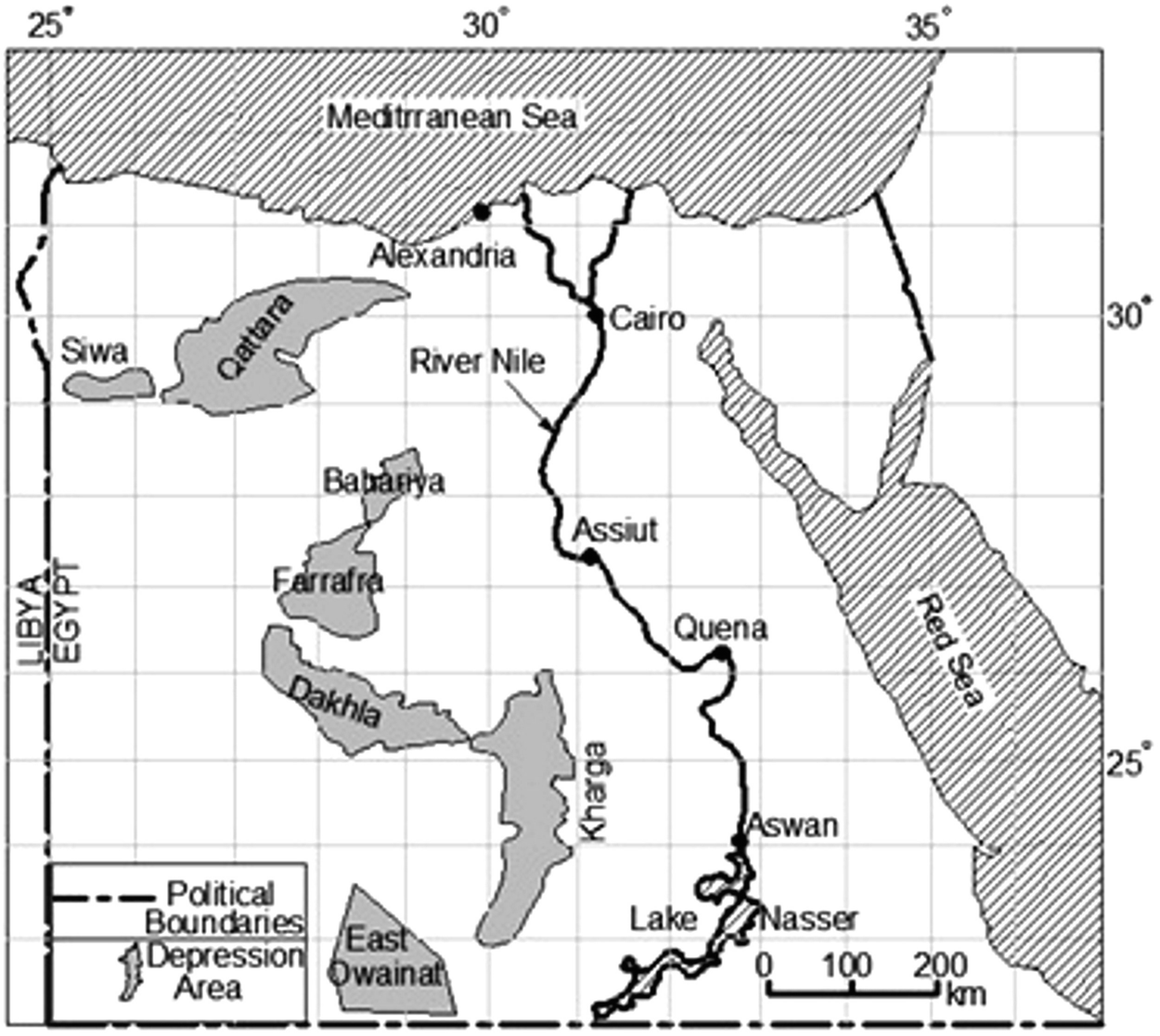
Egypt map showing the major oasis in the New Valley Governorate [4]
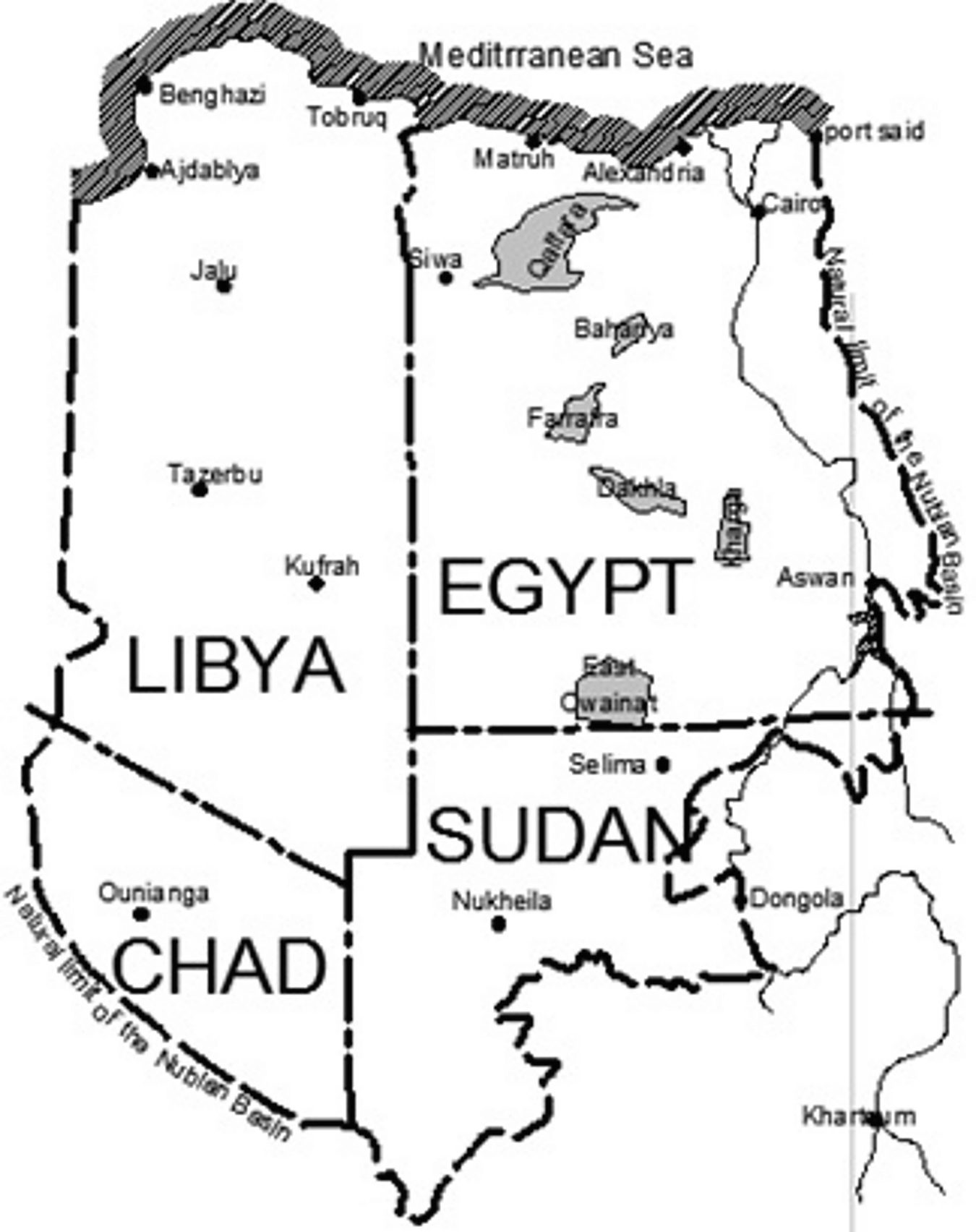
Schematic distribution of Nubian Sandstone under Egypt, Libya, Sudan and Chad [9]
2 Hydrogeology of Aquifer Systems in Egypt
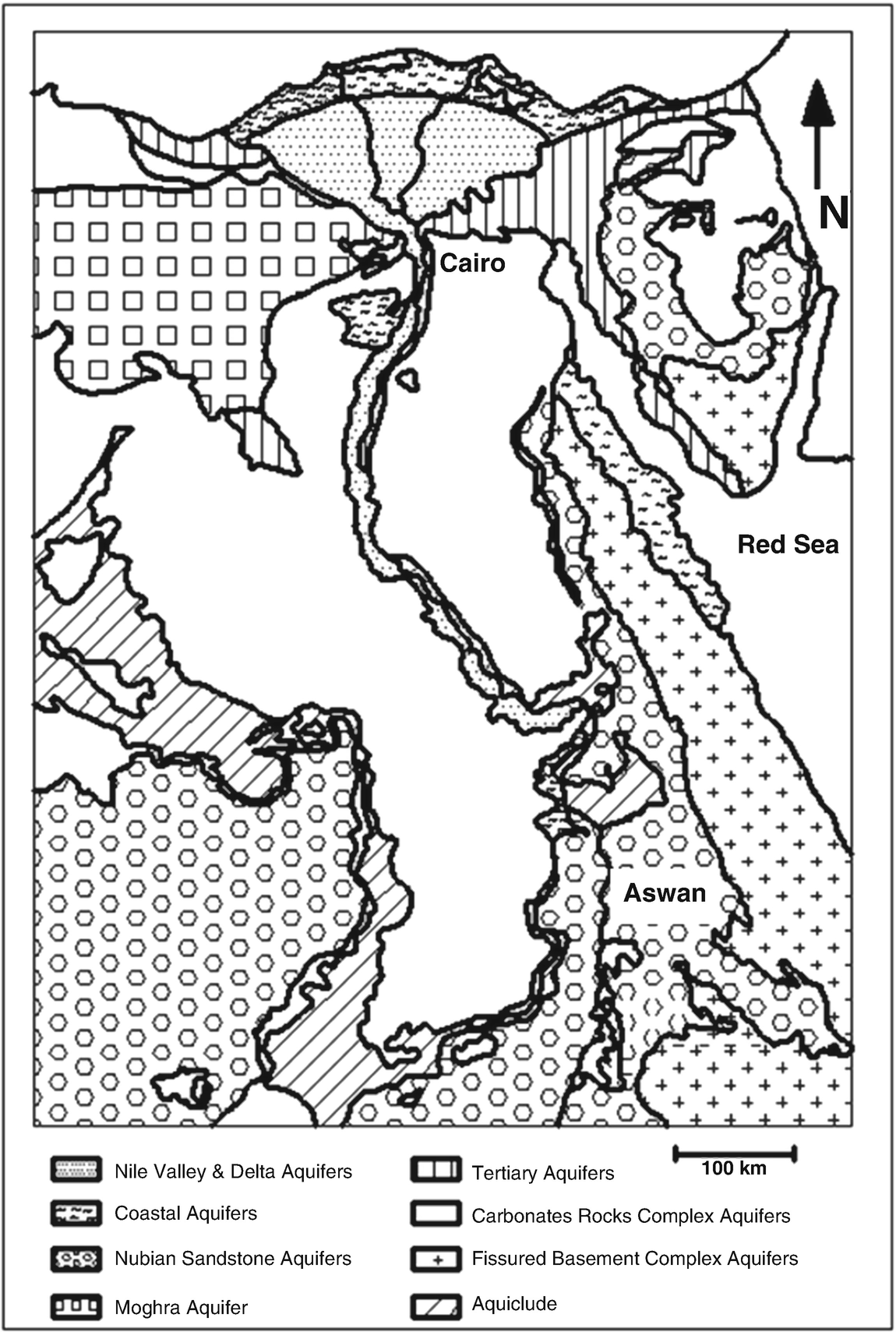
Hydrogeological map of Egypt [1]
2.1 The Nile Valley Aquifer Systems (NVAS)
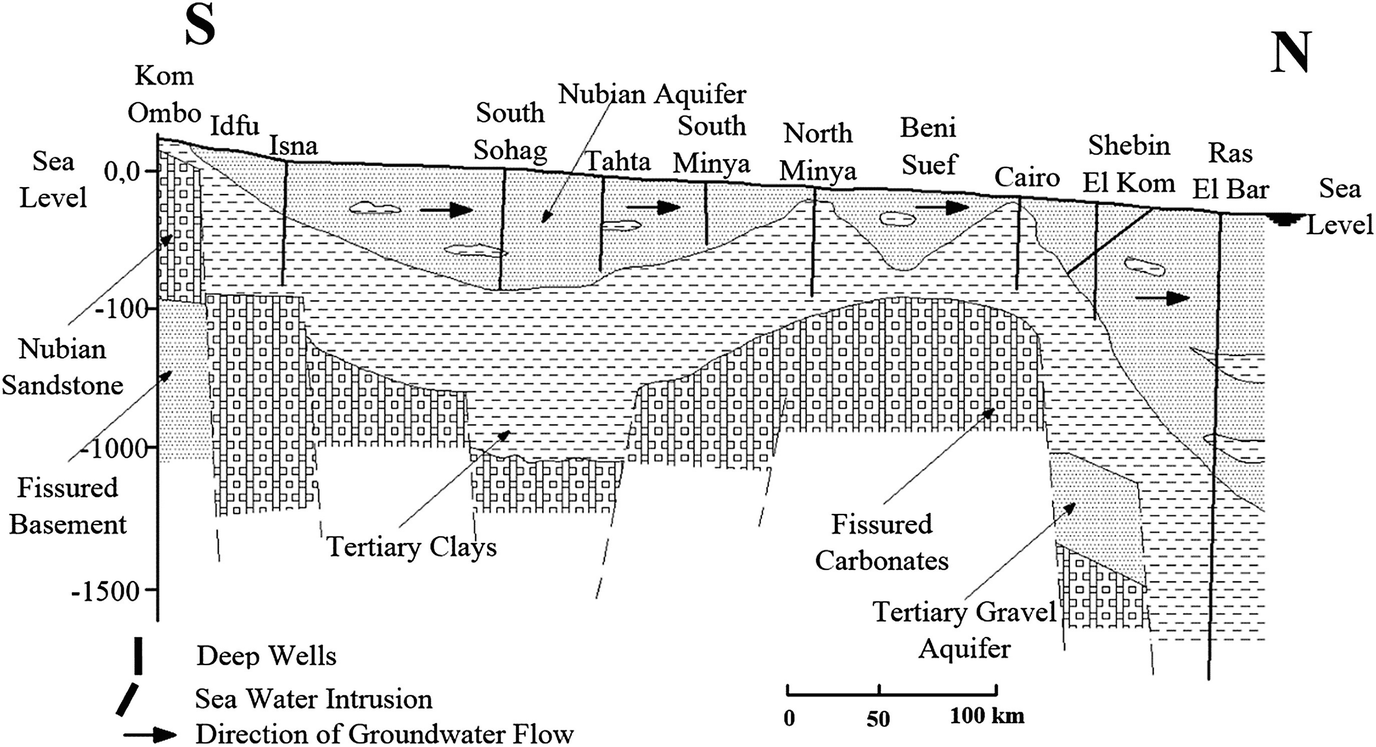
2.2 The Nile Delta Aquifer Systems (NDAS)
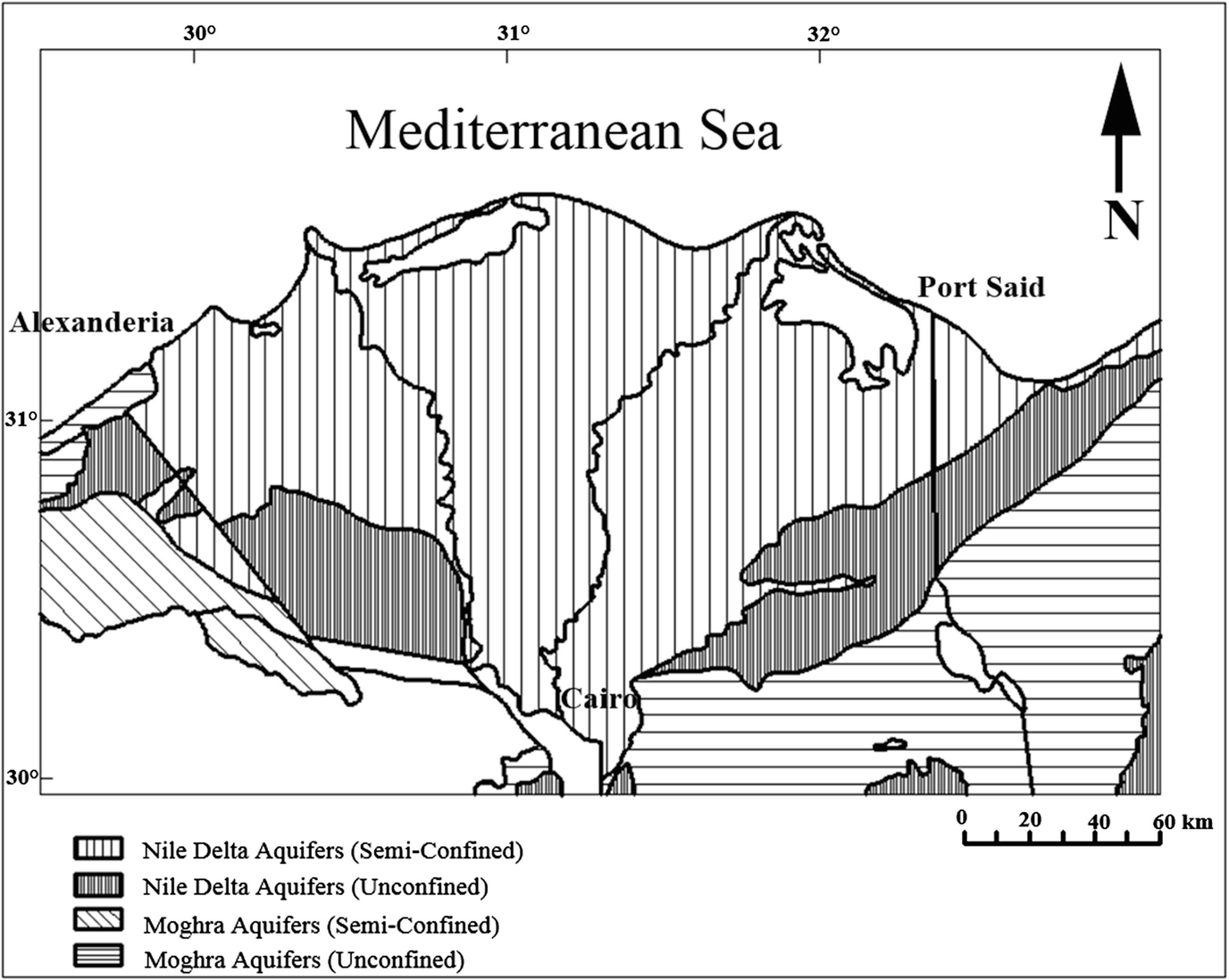
Groundwater aquifers in the Nile Delta [1]
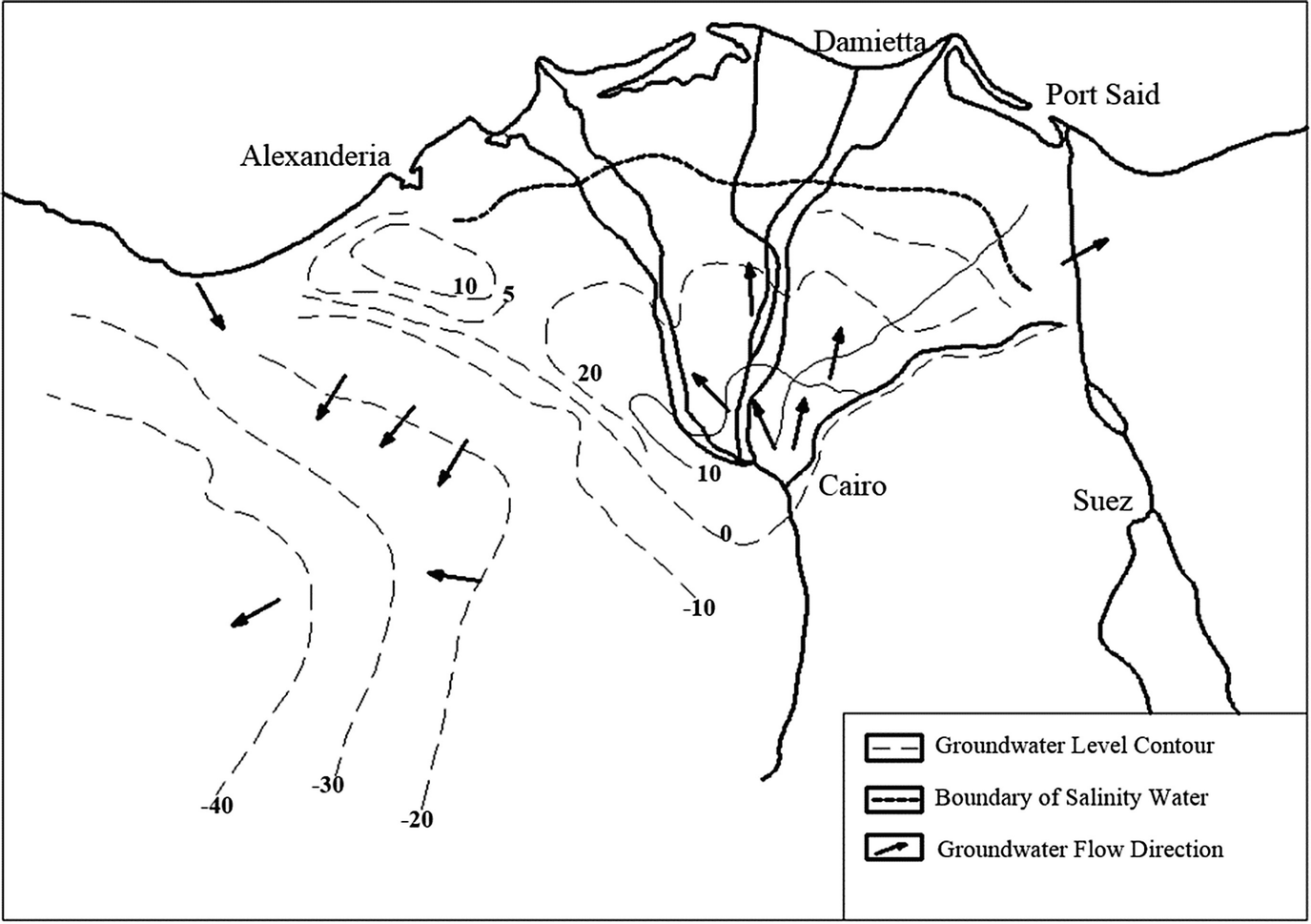
Regional groundwater levels and trends in the Nile Delta and its fringes from hydrogeological map of Egypt [1]
2.3 The Coastal Aquifer Systems (CAS)
The aquifer belongs to the Quaternary and Late Tertiary types. The systems are found along the Mediterranean and Red Sea coasts. The CAS is in the form of scattered pockets. Groundwater in CAS aquifer is in the form of thin lenses over the saline water. The aquifer is considered as renewable aquifer, and it is recharged from rainfall [9].
The CAS aquifer could be divided into two zones, the Mediterranean and Red Sea littoral zones. For the Mediterranean littoral zone, it occupied an area about 10,000 km2. It is characterized by relatively high rainfall up to 200 mm/year. On the other hand, many local aquifer systems are located in the Mediterranean littoral zone. These aquifers are represented by the oolitic limestone aquifer dominating the area to the west of the Nile Delta and by the complex fluviatile sandy gravels and the shallow marine calcareous limestone in North Sinai, near El Arish. On the west of the Nile Delta, the oolitic limestone aquifer has a thickness of 40 m. The aquifer is recharged from winter rainfall and exists under phreatic conditions. It forms a thin layer (±1.0 m thick) floating on the saline water body resulting from seawater intrusion [1].
At El Arish in northern Sinai, the aquifer is characterized by a top sandy aquifer, a middle fluviatile gravelly aquifer and a lower calcareous sandstone aquifer. For the first, it is known as Thaimail, and the groundwater is recharged by local rainfall and occurs at shallow depth from the surface (±2.0). For the middle fluviatile gravelly aquifer, its thickness is about 30 m; the groundwater there is under semi-confined conditions and found at a depth of about 15 m from the surface and is capped by a clayey layer. The last aquifer is the lower calcareous sandstone aquifer which is known also as Kurkar. It is of shallow marine origin and has a wide geographical distribution in northeastern Sinai. It has a thickness of 40 m and extends inland for a distance of about 15 km from the coast. This aquifer directly underlies the fluviatile gravelly aquifer and is connected hydrologically. It is recharged in the foot slope area of Sinai highland, by local rainfall, by runoff water and presumably also by the upward leakage from the high pressure water in the Nubian Sandstone Aquifer System underlying the area. The salinity of the water varies between 3,000 and 5,000 ppm.
For the Red Sea coast aquifers, it extends also into Sinai, comprising essentially the quaternary fluviatile aquifer and the tertiary aquifers. The groundwater in the quaternary fluviatile aquifer is under phreatic conditions with a hydraulic head level same as sea level. For the tertiary aquifers, they are recharged by runoff water, by infiltration from the quaternary aquifers and locally by upward leakage from deep-seated aquifers. The salinity is about 2,000–2,500 ppm.
2.4 The Nubian Sandstone Aquifer System (NSAS)
The NSAS is a regional system and considered as a non-renewable aquifer system. It extends into Libya, Sudan and Chad and western Saudi Arabia with a total area of about two million kilometres. The groundwater volume of NSAS is about 150,000 km3 [15]. NSAS in Egypt could be divided into five subsystems with respect of their locations: at the Western Desert, at Nile Valley, at the Eastern Desert, at Gulf of Swiz and at Sinai. For the NSAS at the Western Desert, it is exploited particularly in the New Valley area, where intensive deep drilling was carried out during the past five decades. There are more than 500 wells that have been drilled to depths from 500 to 1,000 m. Groundwater flow in this aquifer (under New Valley) is towards the northeast with a gradient of 0.5 m/km. The hydraulic parameters are determined in various parts of the New Valley: Kharga, Dakhla, El Bahariya (El Bauity), El Farafra and southward east of Oweinat area. At Kharga and Dakhla Oasis, the salinity decreases from 600 in the upper layers to 200 ppm in the lower layers. On the other hand, NSAS at the Nile Valley extends from the north to the south up to Aswan. West of Cairo, groundwater has been found at a depth of 1 km with high salinity. However, the hydrogeological information about this aquifer is insufficient. The springs of Helwan are mainly connected to this aquifer. At Eastern Desert, NSAS appears in many zones such as El Laqeita area and east of Qena. At El Laqeita area, the groundwater is flowing freely, and the piezometric level is up to 112 m above mean sea level (MSL). The salinity varies in the Eastern Desert between 1,000 and 10,000 ppm. For the NSAS that lies under Gulf of Swiz, its water originates from the watershed in Sinai with salinity about 100,000 ppm. In Sinai Peninsula, NSAS water is basically a fossil water (Late Pleistocene). It is recharged from the uptake areas in Southern Sinai, where the rainfall rate is about 120 mm/year. The flow pattern is in the northward direction. Sinai is bounded by two major rift valley basins, and the local groundwater flow direction is towards these basins: westward in Western Sinai and eastward in the East. Consequently, springs are present near the Gulfs of Suez and Aqaba. In Central Sinai, the piezometric level is about 200 m above sea level, and at the springs of Oyun Moussa (south of Suez), it is close to sea level. The salinity of the water in Central and Southern Sinai is of the order of 1,500 ppm, but it increases to more than 5,000 ppm in North and West Sinai.
2.5 The Moghra Aquifer System (MAS)
The aquifer assigned to the Lower Miocene occupies mainly the western edge of the Delta up to the Qattara Depression. The MAS outcrops on the surface in Wadi El Natrun and Wadi El Farigh [1, 6] illustrate that MAS aquifer has an average thickness of 300 m and is considered as a non-renewable aquifer system. The hydraulic gradients have a value less than 0.2 m/km. The groundwater in the MAS aquifer is a mixture of fossil and renewable water. Discharge of the aquifer is through evaporation in the Qattara and Wadi El Natrun depressions and through the lateral seepage into carbonate rocks in the western part of the Qattara Depression. The base of the aquifer slopes from ground level near Cairo to 1,000 m below mean sea level west of Alexandria. The saturated thickness is between 70 and 700 m. Permeability ranges between 25 m/day east of Wadi El Farigh to less than 1 m/day in the Qattara area and near the coast. Transmissivity ranges between 500 and 5,000 m/day. The salinity of the water changes from less than 1,000 ppm in the east, i.e. close to the main recharging area, to more than 5,000 ppm in the west, i.e. close to the main discharging area.
2.6 The Karstified Carbonate Aquifer System (KCAS)
KCAS is assigned to the Eocene and to the Upper Cretaceous. It predominates essentially in the north and middle parts of the Western Desert. Although the fissured and karstified carbonate aquifer complex occupies at least 50% of the total area of the country, it is the least explored and exploited in Egypt. The recharge to this aquifer is essentially from the upward leakage from the underlying Nubian Sandstone aquifer, and El Tahlawi et al. [1] mentioned that the carbonate complex is generally divided into three horizons: lower horizon assigned to Upper Cretaceous, middle horizon assigned to Lower and Middle Eocene and upper horizon assigned to Middle Miocene. These three horizons are separated by Esna Shale (±100 m) and Daba Shale (200 m). KCAS generally overlies the Nubian Sandstone complex. The hydrogeology of the fissured limestone is not well understood. In Siwa Oasis, the fissured limestone complex has a thickness of about 650 m (Upper Cretaceous to Middle Miocene) and is lying unconformably on the Nubian Sandstone complex. Over 200 natural springs have a total flow of about 200,000 m3/day pumping out water from the top portion of the fissured limestone (Middle Miocene). Groundwater salinity there is from 1,500 to 7,000 ppm. On the other hand, test drilling in Siwa area points to the occurrence of water with a salinity of about 200 ppm in the underlying limestone, which belongs to the Eocene and the Cretaceous.
2.7 The Fissured Hard Rock Aquifer System (FHRAS)
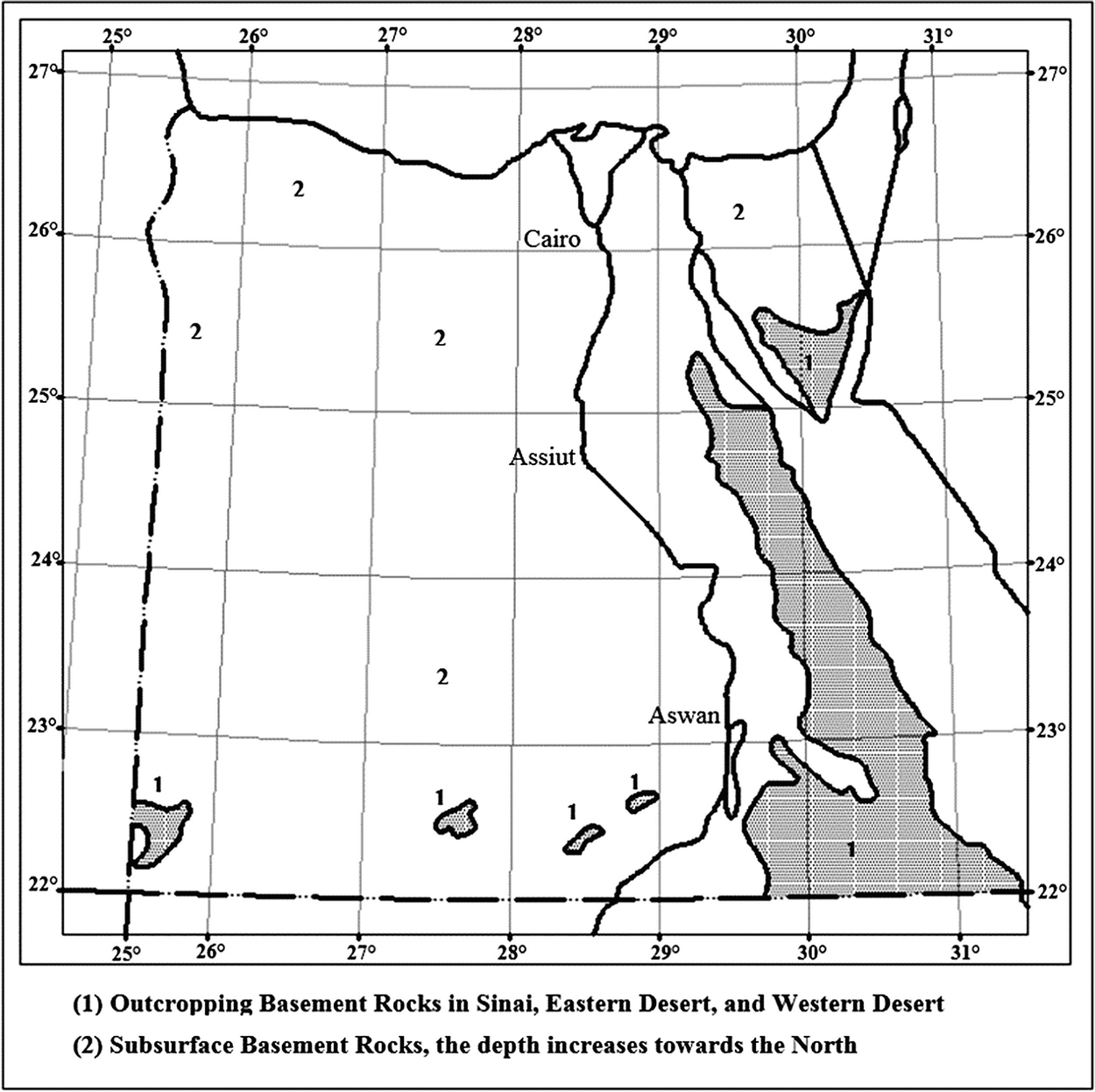
3 Nubian Sandstone Aquifer System in Western Desert
The aquifer assigned to the Paleozoic–Mesozoic occupies a large area in the Western Desert and parts of the Eastern Desert and Sinai. Groundwater can be found at very shallow depths, where the water-bearing horizon is exposed, or at very large depths (up to 1,500), where the aquifer is semi-confined. The NSAS is a regional system. It extends into Libya, Sudan and Chad, and it is a non-renewable aquifer system Mahmod et al. [4], Mahmod and Watanabe [6], Ebraheem et al. [17] illustrate that the Nubian Sandstone Aquifer System (NSAS) is considered to be the largest fossil groundwater aquifer system in the world and is located under the eastern end of the Sahara Desert. NSAS groundwater is shared among Egypt, Libya, Sudan and Chad (see Fig. 2). In Egypt, the NSAS extends under the New Valley Governorate area, where it acts as a local major water source. The total area of the aquifer is approximately 630,000 km2 and at some areas reaches to a depth of 3.5 km below the ground surface [18]. The recharge of the NSAS aquifer is thought to be generally negligible [19]. Due to overuse of NSAS groundwater for industrial and agricultural applications during the last two decades, a significant drawdown in the groundwater table has been observed. The origin of groundwater in the NSAS has been extensively discussed by several authors since approximately 1920; two possibilities for the origin have been proposed. The older postulated concept is that the groundwater is supplied from precipitation in the southern mountainous parts of the NSAS. This concept was suggested primarily by Ball [20] and supported by Sanford [21]. The newer postulate by Sonntag [22] suggested that the bulk of the groundwater mass within the aquifer was originally supplied in situ during the humid pluvial periods (up to 30,000 years B.P.). There are three possible ways of groundwater recharge: regional groundwater influx from areas with modern groundwater recharge, local infiltration through precipitation during wet periods in the past and finally post-High Dam construction seepage of Nile water [24]. In addition, [20, 21, 23] noted that the general flow direction in the NSAS is from the southwest to the northeast Thorweihe and Heinl [25] found that the amount of the current recharge to the NSAS from the south is not significant based on the groundwater velocity, aquifer resistance time and climatic conditions.
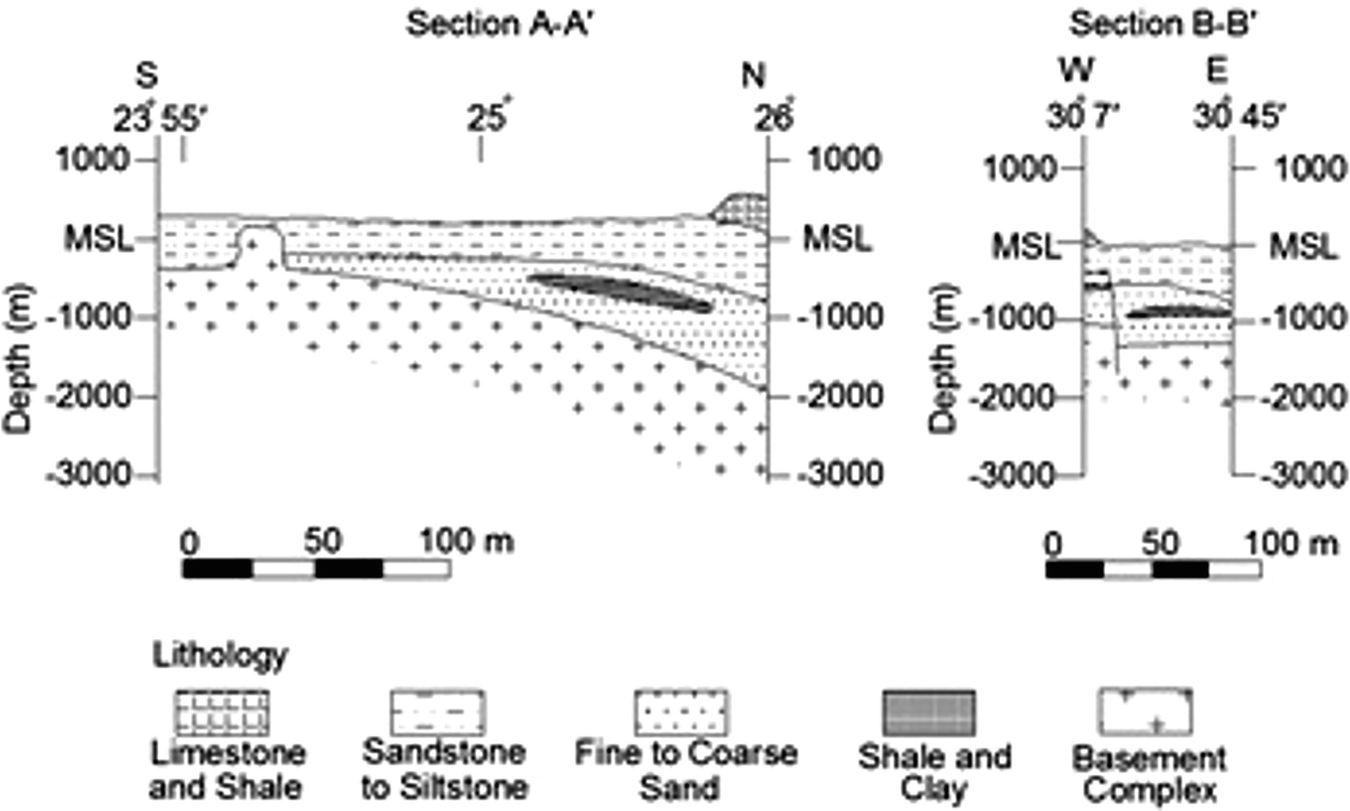
Lamoreaux et al. [23] and Thorweihe and Schandelmeier [30] reported that the thickness of the Nubian Sandstone aquifer beneath the Kharga Oasis ranged from 300 to 1,000 m. Shata [31] noted that in the Kharga Oasis, 32 water-bearing horizons had been recognized within the Nubian Sandstone succession. Shata [31] grouped these water-bearing horizons into three aquifers that include (1) a top layer with an average thickness of 200 m, (2) a middle layer with an average thickness of 200 m and (3) a lower layer with a thickness of approximately 250 m. Lamoreaux et al. [23] mentioned that the NSAS consists of thick sequences of coarse, clastic sediments of sandstone and sandy clay interbedded with shale and clay beds. These clayey impermeable beds restrict the vertical movement of water among water-bearing layers. These beds of lower permeability, however, are lenticular and discontinuous; thus, regionally, the Nubian sandstone forms a single aquifer complex.
4 Groundwater Modelling and Uncertainty
4.1 Model Types
A model is a simulation of areal and temporal properties of a system, or one of its parts, in either a physical or mathematical way. The difficulties of building physical model are obvious in how feasible is the water table (hydraulic head) in a multilayer aquifer exposed to various stresses such as precipitation, surface runoff and leakage from deep underlying strata and then change some of its geometric and hydrogeological properties as needed. For these difficulties, the application of real physical models has been limited to educational and demonstration purposes. Mathematical models are those equations used to analyse groundwater flow. Three mathematical models could be identified; depending upon the nature of equations involved, these models can be empirical, probabilistic and deterministic models. Empirical models are derived from experimental procedures until relations are fitted to some mathematical function. Although empirical models are limited in scope, they can be an important part of more complex problems. Probabilistic (stochastic) models are based on statistics such as probability. These models either have various simple probability distributions of a hydrogeological information or complicated stochastic, time-dependent models. The main problem of the stochastic models, for a wider use in hydrogeology, is that they need large data sets for parameter identification. Moreover, it is difficult to predict the future behaviour of groundwater flow under any change of water table stress. Deterministic models are those models that are predetermined by physical laws governing groundwater flow such as Theis equation and Darcy’s law. These types of models are used to solve complicated groundwater problems as a multiphase flow through a multilayered, heterogeneous, anisotropic aquifer system. There are two categories of deterministic models: analytical and numerical models. Analytical models are used to solve one equation of groundwater flow at a certain time for one point or line of points. Analytical models are easy to be applied to one point with homogeneous aquifer property. Calculation time is increased if the model is applied for many points and if the aquifer is quite heterogeneous. If the situation gets really complicated, such as when there are several boundaries, more pumping wells and several hydraulically connected aquifers, the feasible application of analytical models terminates. Numeric models describe groundwater flow for many points as specified by the user considering heterogeneity of the aquifer. This is achieved by dividing the area of interest into small subdivisions named cells or elements. Then, a basic groundwater flow equation is solved for each cell considering its water balance. The outputs are a distribution of hydraulic heads at points representing individual cells. These points can be placed at the centre of the cell, at intersections between adjacent cells or elsewhere. These models are coded by solving the basic differential flow equation for each cell approximately to finally get an algebraic equation that can be easily solved through an iterative process (numeric) solution. The two most widely applied numeric models are the finite difference model (FDM) and finite element model (FEM). The difference between FDM and FEM is mainly at approximation of the differential flow equation until getting the algebraic equation to be solved then by iterative process.
4.2 Source of Uncertainty
Groundwater management in many arid areas in the world has been difficult due to the limited availability of hydrogeological data. The lack of basic data often limits the implementation of the numerical models for groundwater flow analysis, as well as introduces a problem for model calibration and validation. A deterministic approach is useful to overcome the uncertainty because it depends on variables or parameters with values determined by taking into account previously collected historical information. Although this type of approach has some limitations, it can be very useful in the decision-making process. It is relatively simple and allows for a detailed exploration of other aspects that are sometimes neglected in more sophisticated models.
Natural variability of hydrologic properties of the groundwater aquifer
Limited and incorrect information on hydrogeological variables and parameters that characterize the groundwater flow
Lack of information on future groundwater exploitation rate because of temporal changes of anthropogenic activities, land use, land cover, and climate change
Sensitivity analysis is a straightforward technique that allows the identification of the parameters and variables that have more influence on system performance and allows evaluation of the scale of this influence. Uncertainty in constraints can also be modelled using several different techniques. When uncertainty is small, it can be done in terms of expected values. Chance-constrained models are very useful in reliability analysis (reliability expresses the probability of a system operating without failure). Chance-constrained models describe constraints in mathematical models in the form of probability levels of attainment. The chance constraints can be converted into deterministic equivalents and can therefore be easily incorporated into deterministic programming models. From the previous two sections, it could be concluded that it is difficult to develop a proper groundwater management system given such uncertainties and data limitations when using ordinary numerical models.
5 Overcoming Uncertainty
To implement an optimal groundwater management, temporal and spatial variation of groundwater table should be investigated first as an indispensable factor in groundwater flow analysis. Temporal and spatial variation of groundwater table is an important factor for implementing the optimal management of groundwater resources. A model is suggested to make clear this spatial distribution of groundwater flow by analysing spatial relationships among OWs considering the limited availability of data. This model is linear regression model. Genetic algorithm (GA) was adapted as a technique to estimate the optimized values of the linear parameters considering robustness and high conversion of this method as one of the soft computing techniques (SCTs). This mentioned technique quantifies the spatial structure of the data and produces a prediction of pore pressure change at arbitrary points. A newly developed model named the grey model (GM) was adopted to analyse groundwater flow. This model combines a finite element method (FEM) with GA model to try to obtain the best-fit piezometric level trends compared to observations. On the other hand, the GM has no clear theories that exist for selecting the number of input model trends and the most suitable values of input parameters. Therefore, a modification of the GM is newly proposed and called the modified grey model (MGM) in an attempt to determine a process for selecting the best input models’ trends with the appropriate values of input parameters to achieve acceptable fitting to observations.
5.1 Grey Model (GM)
GM is a combination of a 2D-FEM with genetic algorithms (GA) as the NM and SCT, respectively. FEM was used to analyse groundwater flow under the assumption of hydrogeological and boundary conditions to produce approximate solutions for temporal piezometric level changes. The GA model was used to fit the measured temporal piezometric level changes.
Although the GM has been proposed by some hydrogeologists, it has not yet been widely applied to groundwater problems. The main concept of the GM is combining a numerical model (NM) with a soft computing technique (SCT) Mohammed et al. [32] proposed a GM as a combination of a 3D-FEM with an artificial neural network (ANN) as the NM and SCT, respectively Mohammed et al. [32] used a GM to predict the piezometric level change in the fractured rock mass at Mizunami Underground Research Laboratory (MIU), Japan. In the current study, an FEM and a linear regression model based on genetic algorithms (GAs) were used. FEM was used to analyse groundwater flow under the assumption of hydrogeological and boundary conditions to produce approximate solutions for temporal piezometric level changes. The GA model was used to fit the measured temporal piezometric level changes.
5.1.1 Model Structure


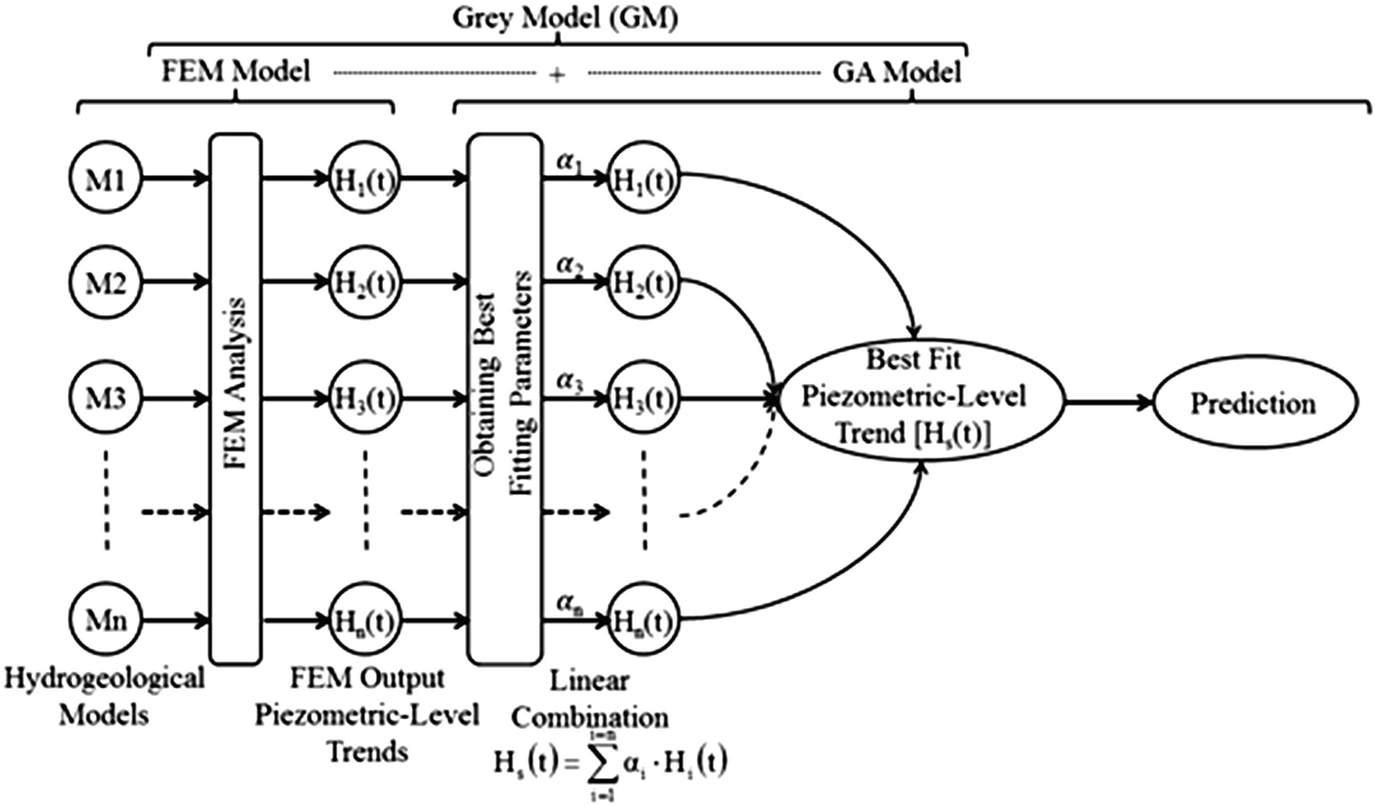
Structure of the developed grey model [4]
- 1.
Generate N different chromosomes by giving random values in the range of 0.0–1.0 as genes. The gene values are adjusted to fit the criterion that the sum of the genes in each chromosome should equal 1.0. The number of chromosomes N is called the population size, and all chromosomes are put in the initial (1st) pool representing the first generation.
- 2.
The previous equation is applied to obtain the reconstructed piezometric level trend (H s(t)). Then, the root mean square error (RMSE) and fitness value (F i) between the measured (H o(t)) and the reconstructed piezometric level trends (H s(t)) for every chromosome are calculated. Chromosomes in the first pool are rearranged based on the probability value of each chromosome (rating process):
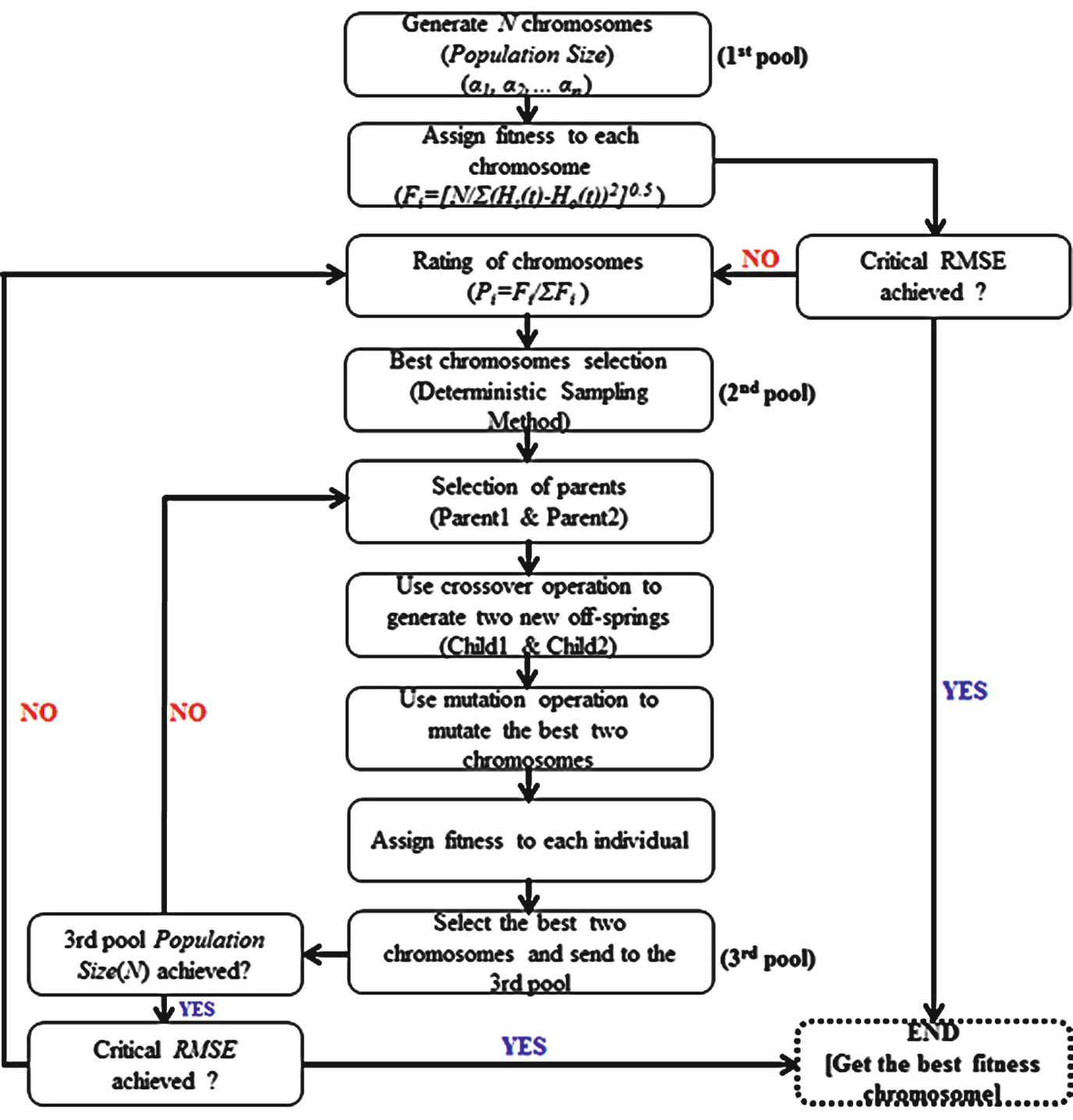
Flow chart describing the GA optimization process [4]


- 3.
Based on the rating process, the best-fit chromosomes are selected and sent to fill the 2nd pool. The selection of chromosomes was performed by using a deterministic sampling method [35, 36]. In this method, the average fit of the population is calculated. Then, the fitness for each chromosome is divided by the average fitness, but only the integer part of this operation is used to select individuals to send to 2nd pool. The entire fraction is used to sort the individuals. The remaining free places in the new population are filled with the chromosomes that have the largest fraction values in the sorted list.
- 4.
Two chromosomes are selected randomly from the second pool and are called parent chromosomes. Two offsprings are created from the parents by using a crossover operation. A crossover is a process to mix the genes of parent chromosomes. In this study, a two-point crossover technique was used [37, 38]. By using the chromosomes of parents and children, four temporal piezometric level trends are calculated, and then two of these trends with a large value of F i are selected. The ratio between the number of chromosomes thus created and the population size is called the crossover probability.
- 5.
The selected two chromosomes constructed and calculated by the crossover process were mutated by changing some gene values using random numbers between 0.0 and 1.0. After mutation, the sum of the gene values should equal 1.0. Among the four chromosomes, the two chromosomes that have the best-fitting values are sent to the 3rd pool. The ratio between the mutated gene and all genes of one chromosome is called the Mutation Probability. Crossover and mutation are repeated until the population size of the 3rd pool is filled; this process is referred to as the second generation.
- 6.
The process from step 2 to step 5 is repeated for a fixed number of generations or until the error between measured and calculated piezometric level trends falls below an assumed critical RMSE value.
All steps from 1 to 6 are applied to a portion of the time series data to train the model (training/learning phase). The other part of the data is used for validation of the resulting weights (prediction/test phase). Due to the limitation of data and to guarantee good results in the prediction phase and future assessments, the majority of the data series is used in training, while the rest is left for the prediction phase.
5.2 Modified Grey Model (MGM)
In the GM, the used GA model has no clear concept for selecting the number of input piezometric level trends and values of input parameters. The input piezometric level trends are the calculated piezometric level trends from the assumed hydrogeological models. On the other hand, the input parameters are the parameters which used to fit the measured observations such as population size, crossover probability, mutation probability and number of generations. For simplicity, in the current study, the number of input piezometric level trends will be named as input models’ trends.
In the current study, this concept is processed, and new model named as modified genetic algorithm (MGA) is proposed trying to select the best input models’ trends for fitting to the measured piezometric level trends. Moreover, the effect of number of input models’ trends on the values of input parameters was studied by meaning of sensitivity analysis for both models GA and MGA. By combining this new proposed model MGA with the FEM model, a new model is produced and named as modified grey model (MGM).
In the current study, the MGM was newly developed for the analysis of groundwater flow. Broadly speaking, the main concept of the MGM is quite similar to the GM because it combines a numerical model (NM) with a soft computing technique (SCT). The GM has not yet been widely applied to groundwater problems. In the GM, the number of input models’ trends and the values of the input parameters are selected hypothetically before obtaining the best-fitting values [4, 32]. The main problem in the GM is that there is no clear concept in the GA model for the selection of either the number of input models’ trends or the values of input parameters, such as population size, crossover probability, mutation probability and number of generations (fitting calculation time). For this purpose, a modification of the GA model was developed to select the input models’ trends that achieve the best fit to the observations. Then, the effects of the best selected models’ trends on the values of GA input parameters were studied. The GA model after modification will be called the modified genetic algorithm (MGA) model. The combination of the best models’ trends will be called the best models combination (BMCk, where k is the number of selected models’ trends). The MGM is the combination of FEM and MGA. As an application for MGM, this model is used to evaluate three different future exploitation/development plans under consideration for the aquifer system to explore the hydrological feasibility of these plans. The MGM simulation is applied for the period from the year 1960 to the year 2100.
5.2.1 Model Structure

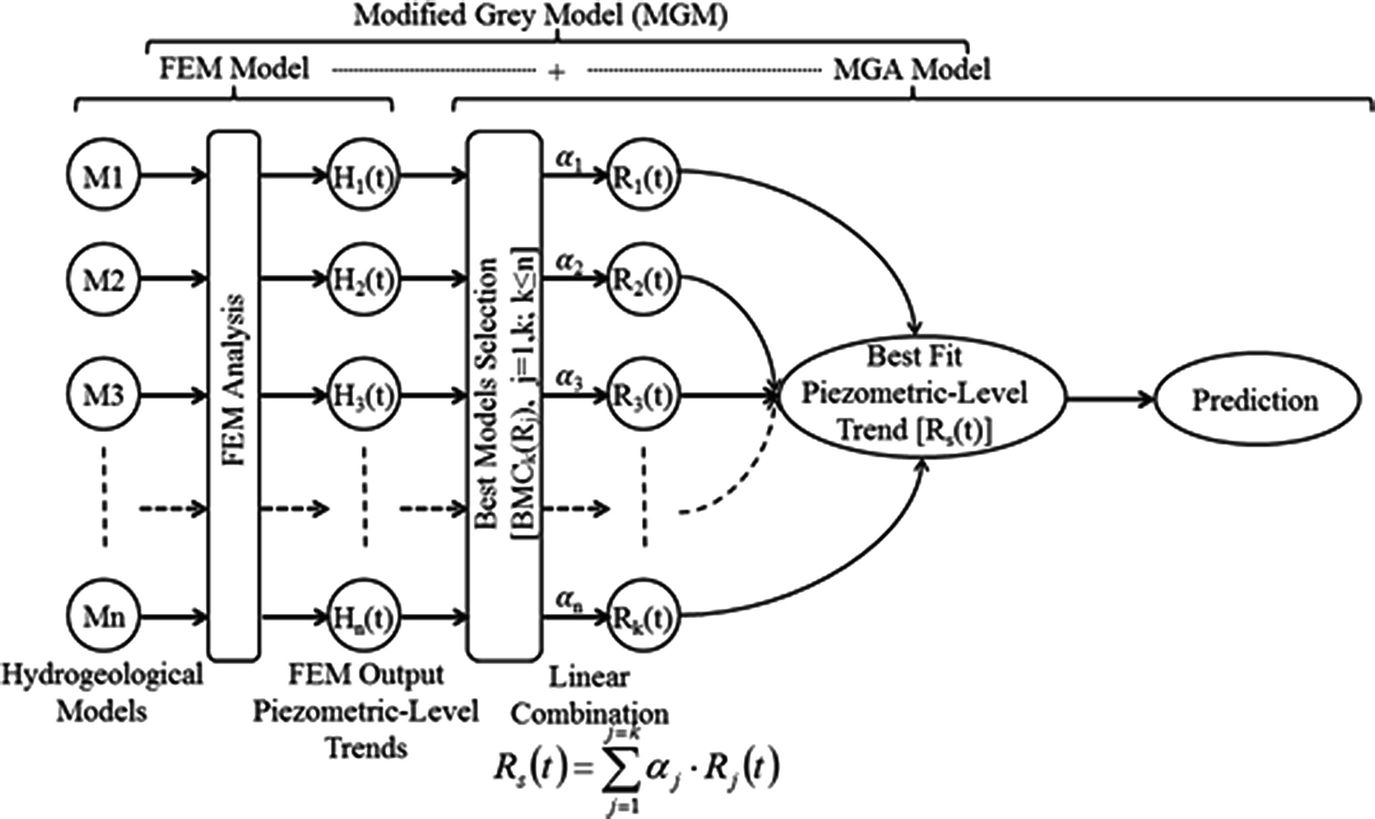
Structure of the developed grey model [6]
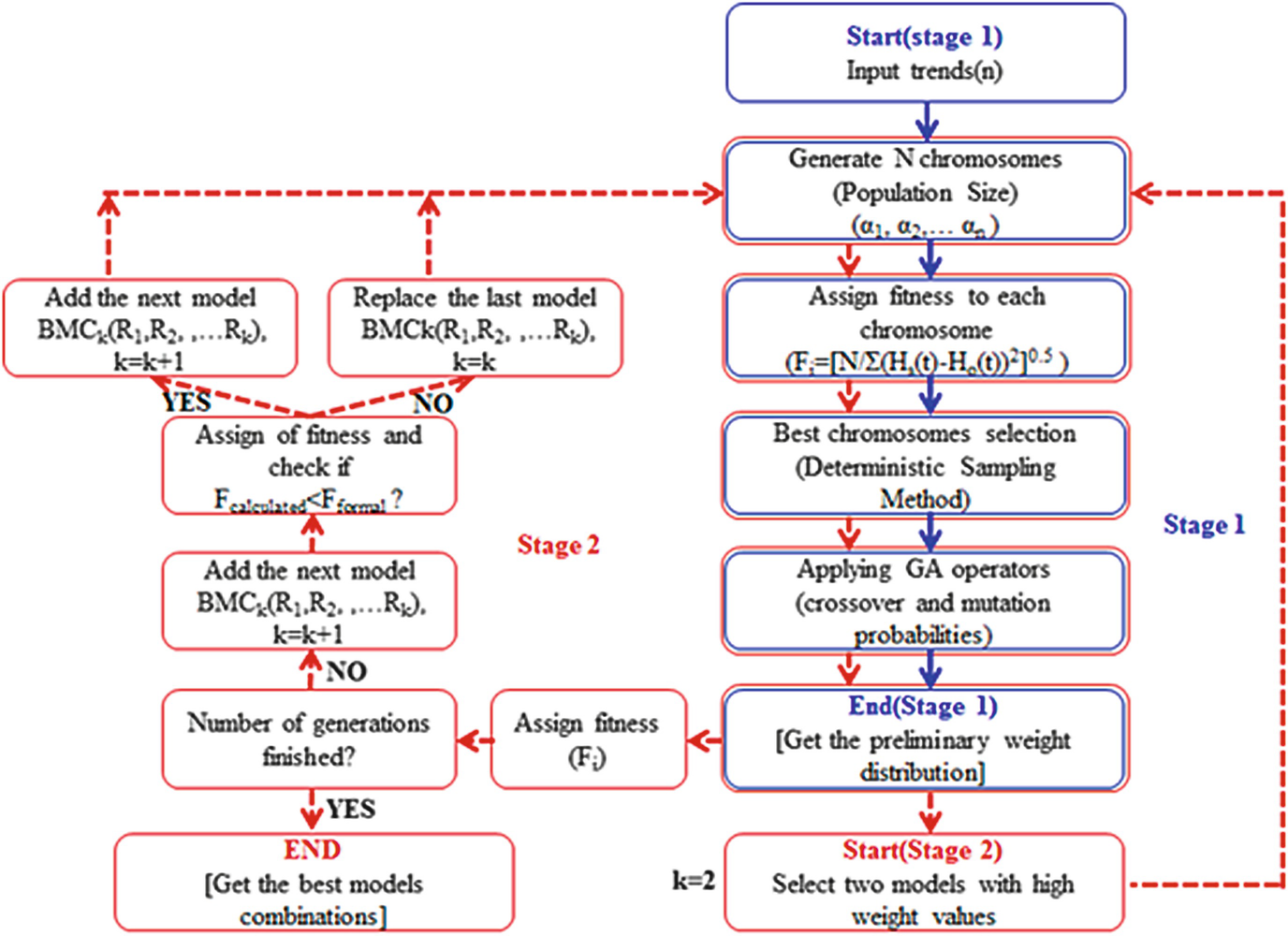
Flow chart describing the MGA optimization process [6]
- 1.
After simulating groundwater flow using the hydrogeological model explained previously, n temporal trends of hydraulic heads (H 1(t), H 2(t),…,H n(t)) are obtained and used as inputs to the GA model. Then, N different chromosomes are generated by giving random values in the range of 0.0–1.0 as genes. The gene values are adjusted to fit the criterion that the sum of the genes in each chromosome should equal 1.0. The number of chromosomes N is called the population size.
- 2.
As the second step of the basic process of the GA model, the reconstructed piezometric level trend (H s(t)) is obtained. Then, the fitness values (F i) between the measured (H o(t)) and the reconstructed piezometric level trends (H s(t)) for every chromosome are calculated.
- 3.
The best-fit chromosomes are selected using a deterministic sampling method. In this method, the average fit of the population is calculated. Then, the fitness for each chromosome is divided by the average fitness, but only the integer part of this operation is used to select individuals. Then, the entire fraction is used to sort the individuals. The remaining free places in the new population are filled with the chromosomes that have the largest fraction values in the sorted list.
- 4.
These “n” models’ trends are processed by GA processes (crossover and mutation processes) to obtain the final weight parameters (α 1, α 2,.. α n). At the initial stage, the weight parameters are given as random numbers. Then, the weight parameters are pursued through the repetition of crossover and mutation processes until completing the selected number of generations. Crossover and mutation processes are represented by two operators: crossover probability and mutation probability.
- 1.
The first two inputs (BMCk(R j(t)); j = 1,k; k = 2) are combined using the GA model (stage 1 procedures). Then, R s(t) is calculated, and the fitness with the observed trend R o(t) is calculated.
- 2.
The third input R 3(t) is added to the formal combination to become BMC3(R 1(t), R 2(t), R 3(t)), and then the fit is recalculated.
- 3.
If the calculated fit is less than the formal fit (F calculated < F formal), then the input will be added to the combination to become BMC4(R 1(t), R 2(t), R 3(t), R 4(t)). On the contrary, if the calculated fit is larger than the formal fit, the last input in the combination BMC3(R 1(t), R 2(t), R 3(t)) will be replaced by its next input to become BMC3(R 1(t), R 2(t), R 4(t)). This process is continued until the selected number of generations has been completed.
- 4.
The best models combination (BMCk((R 1(t),R 2(t),…R k(t)) is obtained.
The two stages explained above are applied on a part of the time series data as training for the model (training phase). The other part of the data is used for the validation of the resulting weights (test phase). Due to the limited data and to guarantee good results at the prediction phase and in future assessment, a large percentage of the data is used in the training phase, and the other remains for the prediction phase.
6 Application of MGM on the NSAS Under Kharga Oasis
As applications of the new proposed model MGM, future assessment of piezometric level change was analysed by developing three exploratory scenarios of groundwater withdrawal that involved either expanding the present extraction rate or redistributing the groundwater withdrawal over the recent working production wells (RWPWs).
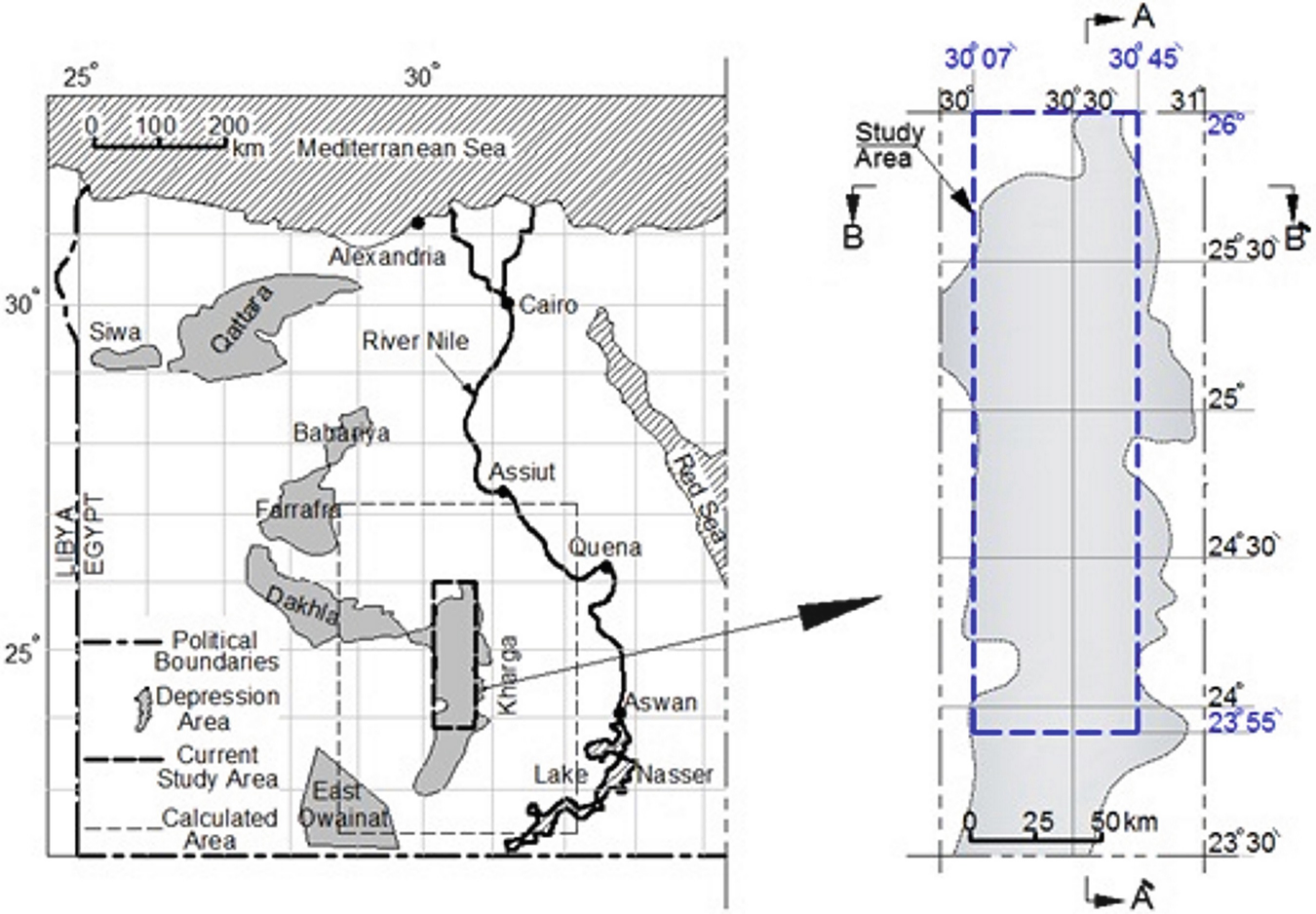
Location map of the study area showing observed sites [6]
The Kharga Oasis is situated in the tropical arid climate zone. The maximum daytime temperature reaches up to 45–50 °C in the summer; however, the temperature drops below zero °C at night in the winter. The Kharga Oasis is one of the driest areas of the Eastern Sahara, which thus makes it one of driest areas on Earth [39]. The average potential evaporation rate reaches approximately 18.4 mm/day, and the mean annual value of the relative humidity is approximately 39%. The annual precipitation is extremely low and is almost insignificant (1 mm/year) [40].
Thorweihe and Heinl [25] found that the amount of the current recharge to the NSAS from the south is not significant based on the groundwater velocity, aquifer resistance time and climatic conditions Heinl and Thorweihe [19] estimated that the flow velocity in the deep aquifer is approximately 1 m/year, which means the groundwater would require over 100,000 years crossing the distance from either tropical infiltration areas or the River Nile to reach the Kharga Oasis part of the NSAS. Because of the known precipitation and potential evaporation conditions in the study area, recharge of the Kharga Oasis part of the NSAS was neglected in the current study.
Lamoreaux et al. [23] and Ebraheem et al. [18] reported that the thickness of the Nubian Sandstone aquifer beneath the Kharga Oasis ranged from 300 to 1,000 m Shata [31] noted that in the Kharga Oasis, 32 water-bearing horizons had been recognized within the Nubian Sandstone succession Shata [31] grouped these water-bearing horizons into three aquifers that include (1) a top layer with an average thickness of 200 m, (2) a middle layer with an average thickness of 200 m and (3) a lower layer with a thickness of approximately 250 m Lamoreaux et al. [23] mentioned that the NSAS consists of thick sequences of coarse, clastic sediments of sandstone and sandy clay interbedded with shale and clay beds. These clayey impermeable beds restrict the vertical movement of water among water-bearing layers. These beds of lower permeability, however, are lenticular and discontinuous; thus, regionally, the Nubian sandstone forms a single aquifer complex.
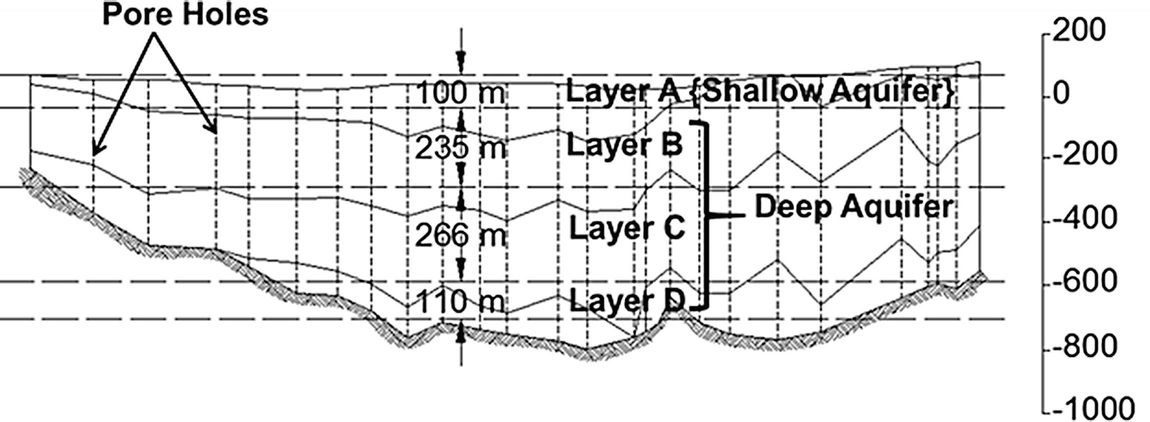
Classification of water-bearing layers compiled from Lamoreaux et al. (1985) [9]
Shata [31] reported that the transmissivity and storage coefficient values for the NSAS under the Kharga Oasis were in the range of 100–2,000 m2/day and 1.5 × 10−4 to 1.5 × 10−2, respectively Hesse et al. [41] reported that the hydraulic conductivity of the Kharga part of the NSAS has an average value of 2.16 m/day Ebraheem et al. [18] noted that the average hydraulic conductivity for the regional NSAS is in the range of 0.0864 to 0.864 m/day, with an average storage coefficient of 1.0 × 10−4. However, these hydraulic properties have not been confirmed for the entire aquifer.
Summary of RWPW data throughout subdivisions of the study area
Area no. | Area name | No. of RWPWs | Well depth (m) | Q m3/h |
|---|---|---|---|---|
1 | Monera | 10 | 101–720 | 14–117 |
2 | Sherka | 11 | 125–703 | 14–114 |
3 | Kharga | 41 | 88–706 | 28–177 |
4 | Jenah | 14 | 89–804 | 31–329 |
5 | Bulaq | 14 | 163.5–813 | 46–216 |
6 | Garmashin | 12 | 217–673 | 20–205 |
7 | Paris | 44 | 76–600 | 14–229 |
8 | Darb El-Arbeen | 41 | 91.3–485.4 | 44–56 |
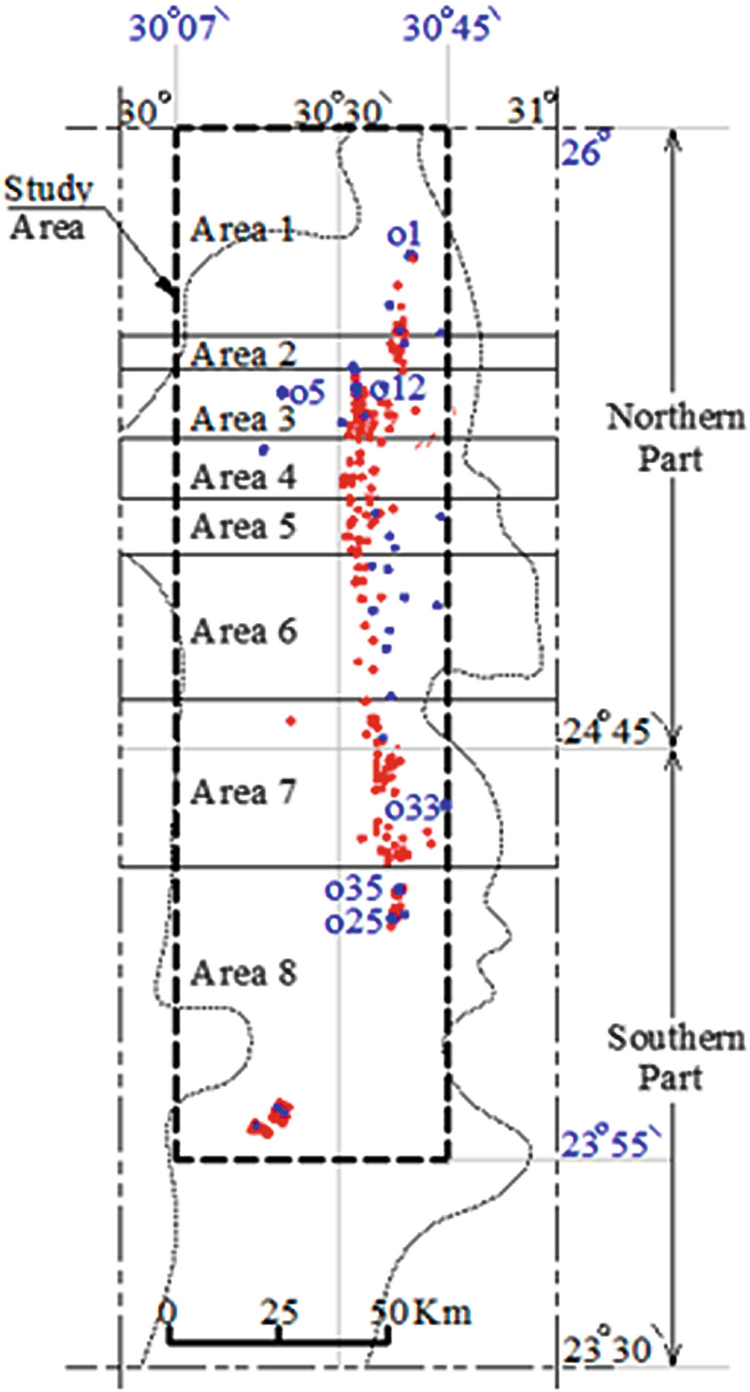
Distribution of RWPWs and OWs over the Kharga Oasis; RWPWs shown in red and OWs in blue [6]. Dotted line indicates the schematic boundary of the Kharga Oasis. Dashed line indicates the current study area
Q is the discharge from each well
6.1 Hydrogeological Model
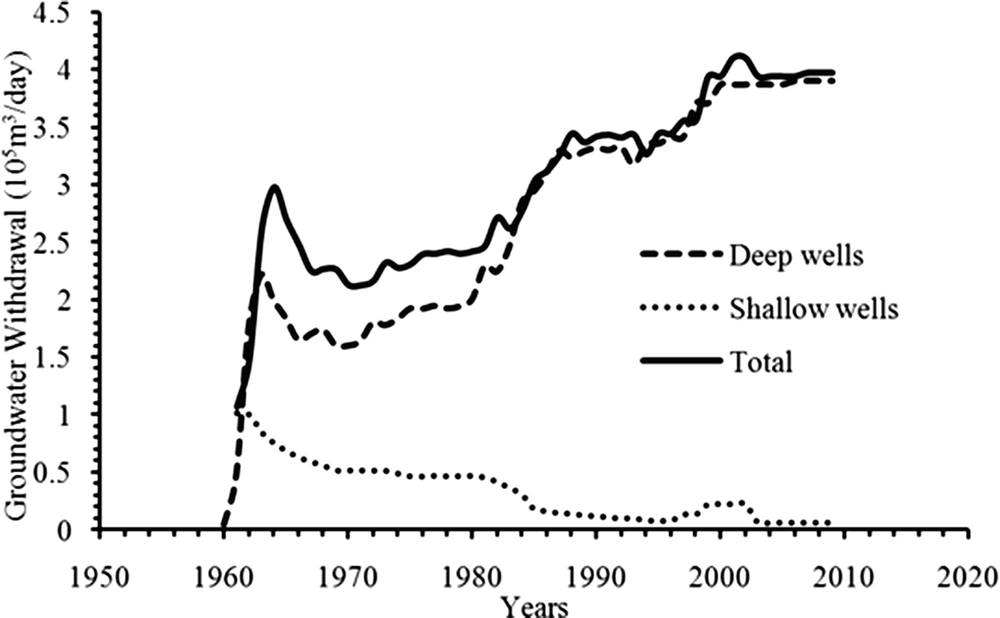
History of groundwater withdrawal from deep and shallow aquifers [4]
6.2 Initial and Boundary Conditions
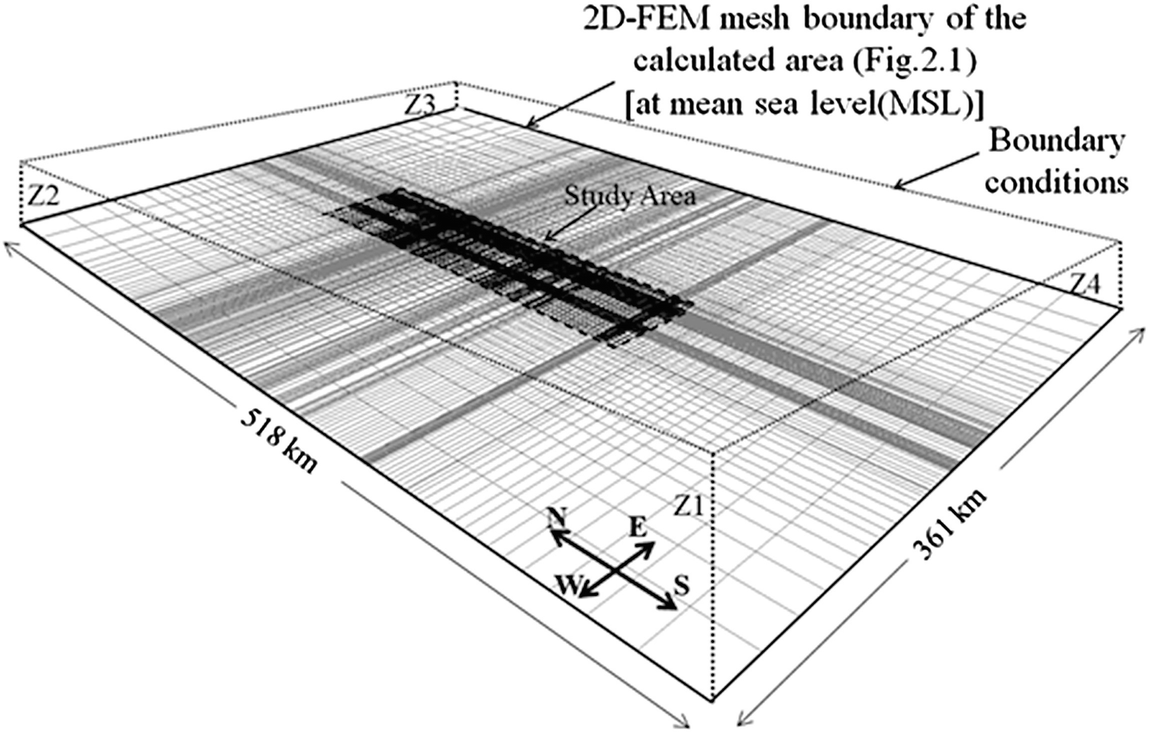
Adopted 2D-FEM mesh geometry for the calculated area, and the study areas. Z1–Z4 are the assumed hydraulic heads at the corners of the calculated area (after six)
Proposed hydrogeological models
Model name | Corner hydraulic heads | T xx (m/day) | T yy (m/day) | S × 10−3 | |||
|---|---|---|---|---|---|---|---|
Z1 (m) | Z2 (m) | Z3 (m) | Z4 (m) | ||||
M1 | 87 | 220 | 150 | 105 | 50 | 50 | 32.8 |
M2 | 37 | 170 | 100 | 55 | 50 | 50 | 3.28 |
M3 | 27 | 160 | 90 | 45 | 50 | 500 | 3.28 |
M4 | 37 | 170 | 100 | 55 | 5 | 50 | 3.28 |
M5 | 37 | 170 | 100 | 55 | 500 | 500 | 32.8 |
M6 | 85 | 85 | 85 | 85 | 50 | 500 | 3.28 |
M7 | 37 | 170 | 100 | 100 | 50 | 500 | 3.28 |
M8 | −282 | 484 | 123 | −111 | 50 | 500 | 3.28 |
M9 | −282 | 484 | 123 | −90 | 50 | 500 | 3.28 |
M10 | −282 | 490 | 123 | −111 | 50 | 500 | 3.28 |
M11 | −300 | 484 | 123 | −111 | 50 | 500 | 3.28 |
M12 | −297 | 495 | 108 | −126 | 50 | 500 | 3.28 |
M13 | −282 | 484 | 123 | −111 | 138 | 500 | 3.28 |
M14 | −282 | 484 | 123 | −111 | 50 | 50 | 3.28 |
M15 | −232 | 534 | 123 | −61 | 97 | 500 | 3.28 |
M16 | −282 | 484 | 123 | −111 | 138 | 500 | 32.8 |
To reduce the direct effects of boundary conditions on the results, the calculated area was extended beyond the study area boundary, as shown in Fig. 13. This area was subdivided into 24,069 rectangular elements and 24,396 nodes with the RWPWs and OWs located on mesh nodes. The elements around the RWPWs and OWs were set as the smallest elements with the sizes gradually increasing towards the boundary of the calculated area, as illustrated in Fig. 17. The minimum and maximum lengths of the element sides were 377 m and 7,000 m, respectively.
6.3 Proposed Future Scenarios for Groundwater Withdrawal
Although the total discharge extracted from the Kharga Oasis part of the NSAS is known from 1960 to 2009 (Fig. 16), the discharge for each production well in the same period is unknown. For this reason, a scenario of groundwater withdrawal of each RWPW was assumed to follow the same groundwater withdrawal trend as the total discharge curve given in Fig. 16, considering that the discharge was almost steady within the period 2005–2009. From 2009 to the present, groundwater withdrawal was assumed to continue being steady. Hereafter, for each RWPW, three scenarios of groundwater withdrawal are assumed, considering that no new production wells will be constructed. The main criterion in the three proposed scenarios is to keep the sum of groundwater withdrawal from the current study area constant. These scenarios are explained as follows:
Scenario 1: The present groundwater withdrawal is increasing and kept constant until the final simulation year of 2100.




6.4 Sensitivity Analysis
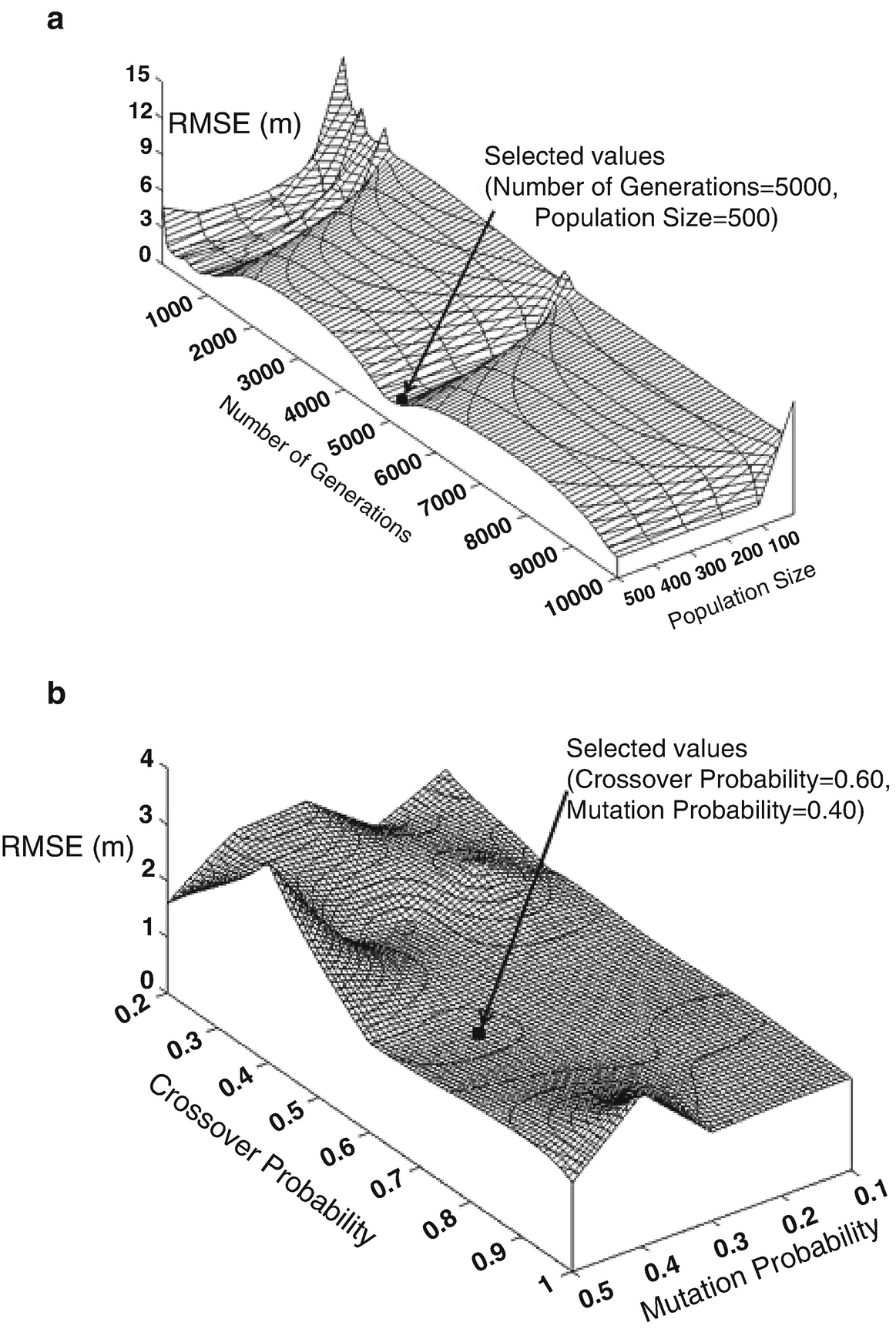
Sensitivity range analysis for the GM: (a) number of generations and population size; (b) crossover and mutation probabilities [6]
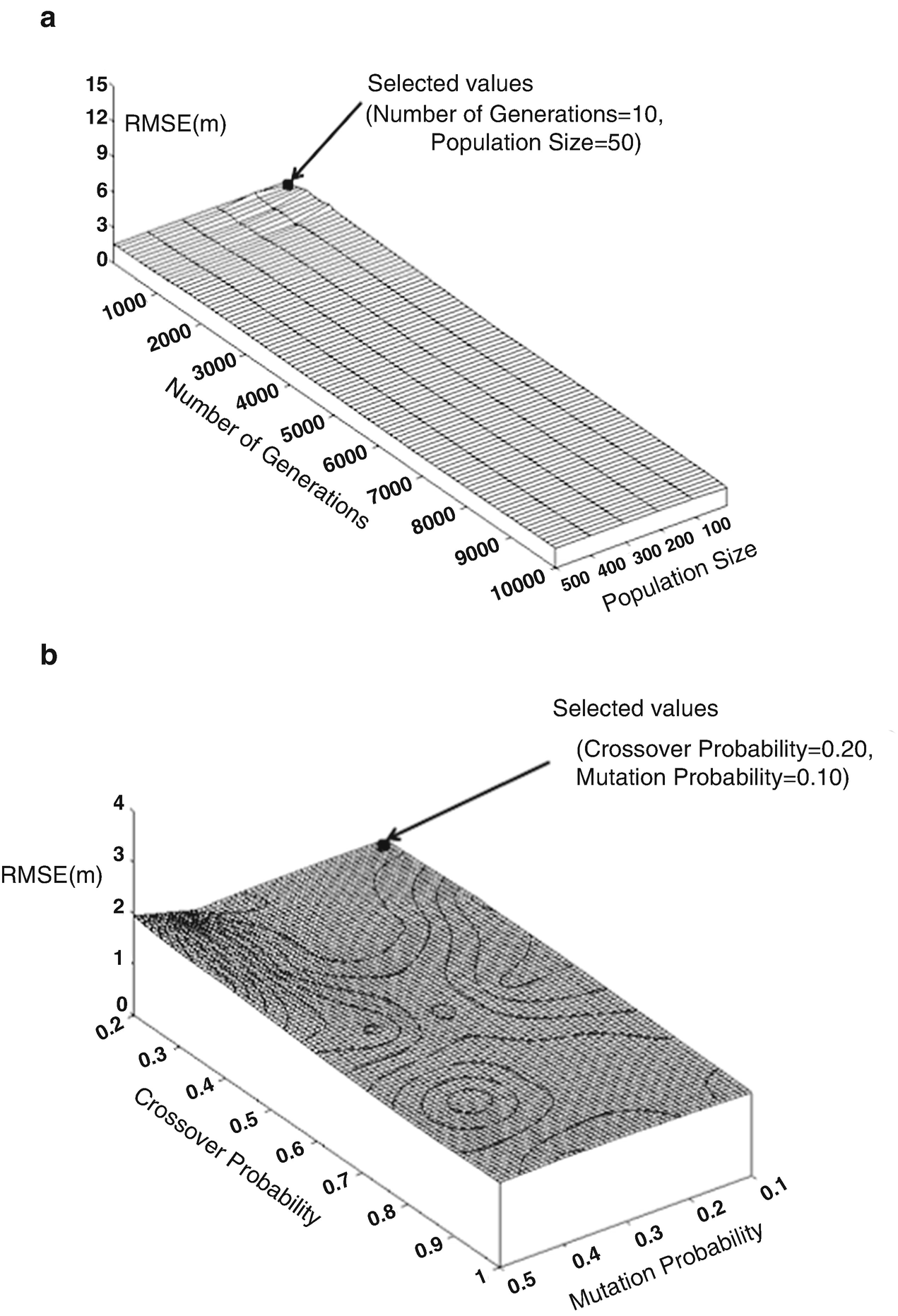
Sensitivity range analysis for the MGM: (a) number of generations and population size; (b) crossover and mutation probabilities [9]
Setting of GA and MGA models parameters [6]
Parameters | For minimum RMSE | Selected parameters | ||
|---|---|---|---|---|
GA | MGA | GA | MGA | |
Number of generations | 5,000 | 10–10,000 | 5,000 | 10 |
Population size | ≥100 | 10–500 | 500 | 50 |
Crossover probability | 0.60–0.70 | 0.2–1.0 | 0.60 | 0.20 |
Mutation probability | ≥0.35 | 0.1–0.4 | 0.40 | 0.10 |
6.5 Future Assessment of Temporal Piezometric Level Change
The good agreement between the measured and calculated piezometric level trends in the short period simulation (1979–2005) was considered to be a verification of the MGM presented in this study. Thus, the MGM can be used to predict piezometric level trends and drawdown of the groundwater table over long periods, as well as to evaluate the hydrological feasibility of the proposed groundwater withdrawal plans (scenarios 1, 2 and 3). With regards to the proposed scenarios for groundwater withdrawal described previously, the simulated declines in hydraulic head at the target OWs were calculated for the period 1960 to 2100.
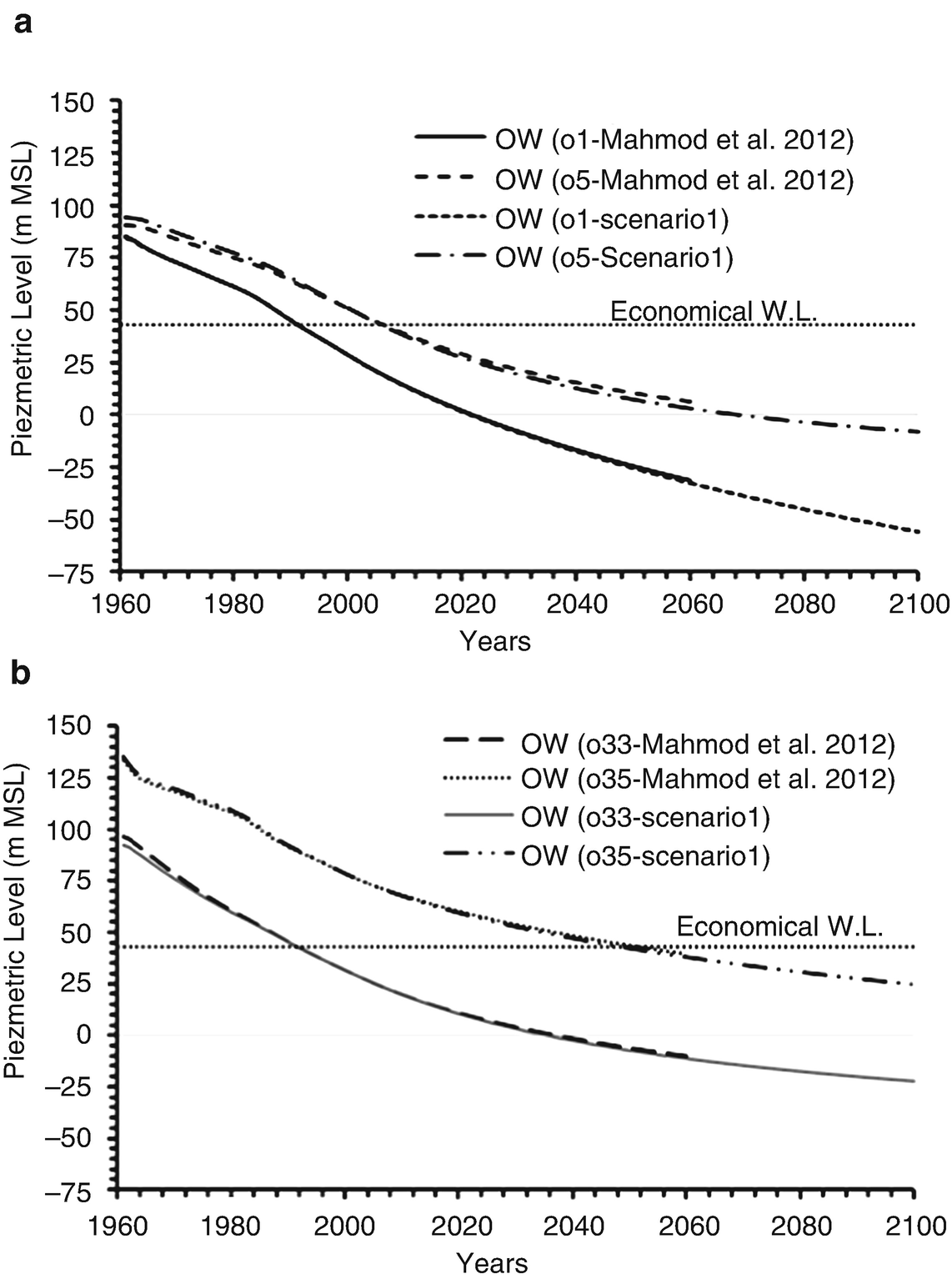
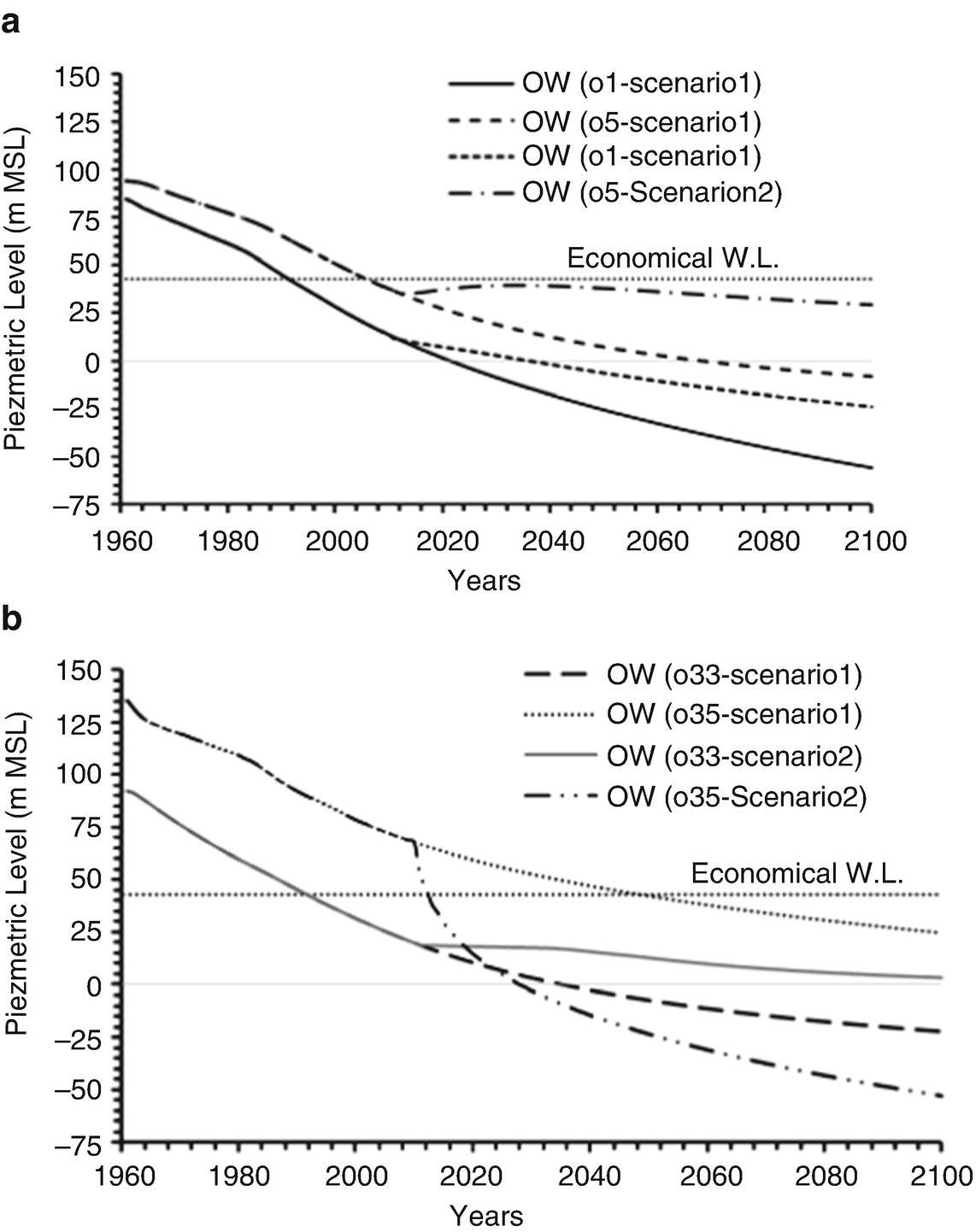
Comparison of MGM-simulated piezometric levels for scenario 2 and scenario 1 until the year 2100: (a) OWs o1 and o5; (b) OWs o33 and o35 [6]
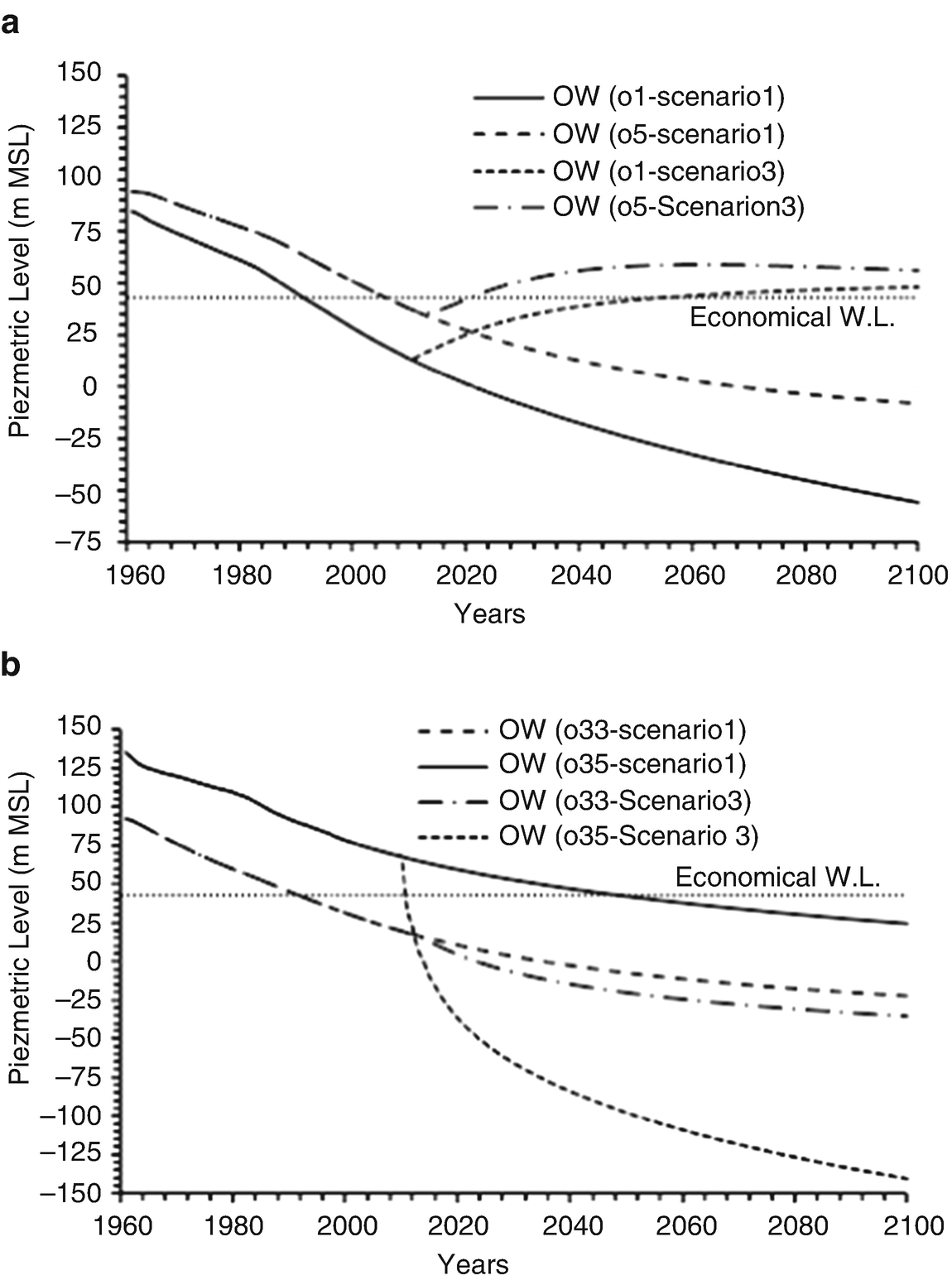
Comparison of MGM-simulated piezometric levels for scenario 3 and scenario 1 until the year 2100: (a) OWs o1 and o5; (b) OWs o33 and o35 [6]
Hydraulic head differences in the economical piezometric levels for the target OWs
OW | Difference from the economical piezometric level (43 m) by 2100 | ||
|---|---|---|---|
Scenario 1 | Scenario 2 | Scenario 3 | |
o1 | −98.88 | −66.89 | 4.98 |
o5 | −51.16 | −13.58 | 13.27 |
o33 | −65.22 | −39.76 | −78.26 |
o35 | −18.33 | −96.08 | −183.62 |
The MGM shows a better fitting performance than the ordinary GM, for which the best input models’ trends are recognized by means of the best models combination (BMCk). On the other hand, the MGM produced a wide range of input parameter values, which guarantees goodness of fit with any hypothetical value of these parameters. Moreover, a high reduction in required calculation time was observed for reaching the best fit to the observations.
6.6 Evaluation of the Proposed Groundwater Withdrawal Scenarios
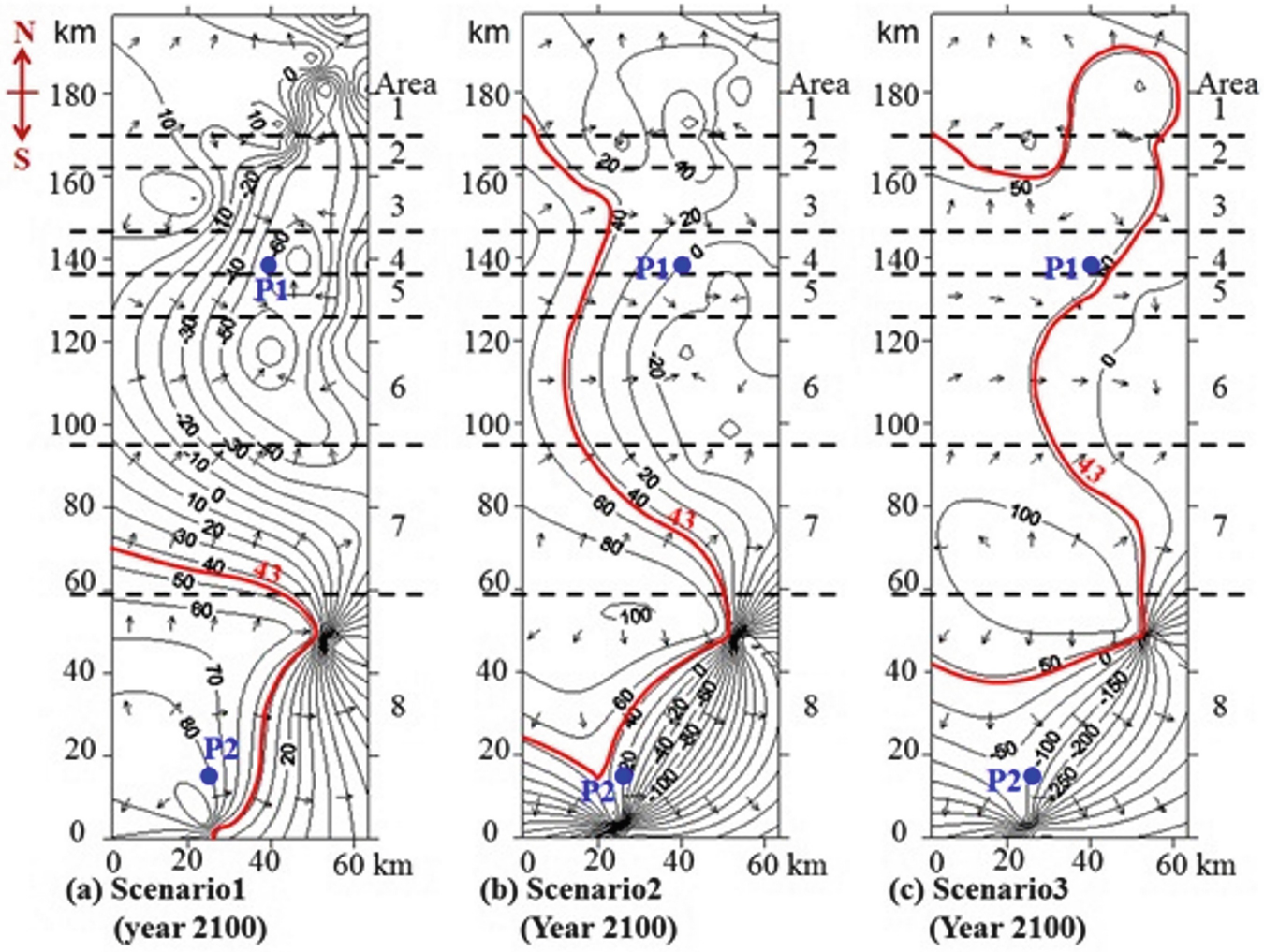
Comparison between the simulated piezometric level contours along with groundwater flow vectors in the study area for the proposed scenarios [9]
7 Conclusions
In this study, groundwater flow analysis was performed using the developed modified grey model (MGM) which combines the finite element method (FEM) and the new developed modified genetic algorithm (MGA). The analysis of observed data shows enormous pore pressure decrease by 50 m in the northeastern part of the study area within the period 1979–2005. The MGM produced stable results for piezometric level simulations while using a wide range of input parameters values compared to the ordinary grey model (GM). Moreover, the time required for calculations to achieve proper convergence with the measured piezometric level trends was reduced by 99.8% compared to the GM. MGM used a smaller number of input models’ trends than the GM for achieving goodness of fit, with a percentage of reduction in the range of 68.75–81.25%. The RMSE was in the ranges of 0.63–2.936 m and 0.439–2.665 for the MGM and the GM, respectively. The results from the various scenarios of groundwater withdrawal demonstrate that if the present extraction rate is expanded (scenario 1), the groundwater piezometric level continuously declines and drops below the economical piezometric level until the year 2100 at the end of the simulation period. To avoid groundwater depletion in the Kharga Oasis, the extraction rate in the M-region is lowered by 20% and added to Area 8 (scenario 2). The planned extraction rate is not feasible for the future and will have a negative impact on the piezometric level of Area 8. However, a recovery in the piezometric levels for all other subdivisions was observed. For the 3rd scenario of groundwater withdrawal, the recovery head for the northern area increased more than in scenario 2, as well as reached above the economical piezometric level. However, a large drawdown of the piezometric level of the southern part was observed.
8 Recommendations
To protect the groundwater table from being severely drawn down, it is recommended that new production wells be constructed in the southern part of the current study area far enough from the RWPWs. For reliable piezometric measurements, a network of monitoring wells should be drilled that cover the whole area. Regular water-level measurements (at least monthly) would provide the basic data needed for time series compilations in the future, which could give feedback on the constructed model. For the future, it is suggested that the MGM be used for simulating the total piezometric level surface of the whole area and hence confirm the MGM performance. The proposed model (MGM) is significant for the decision-makers to have knowledge about groundwater resources in their regions. For that, MGM could be useful to study the effect of increased pressure on the finite water resource on the sustainability of agricultural production and livelihoods as well as the social cohesion within new settler communities. Moreover, a new developed monitoring system could be proposed to reduce the monitoring cost based on giving up the idea of constructing new observation wells.